Vol. 71, No. 20 (2022)
2022-10-20
GENERAL
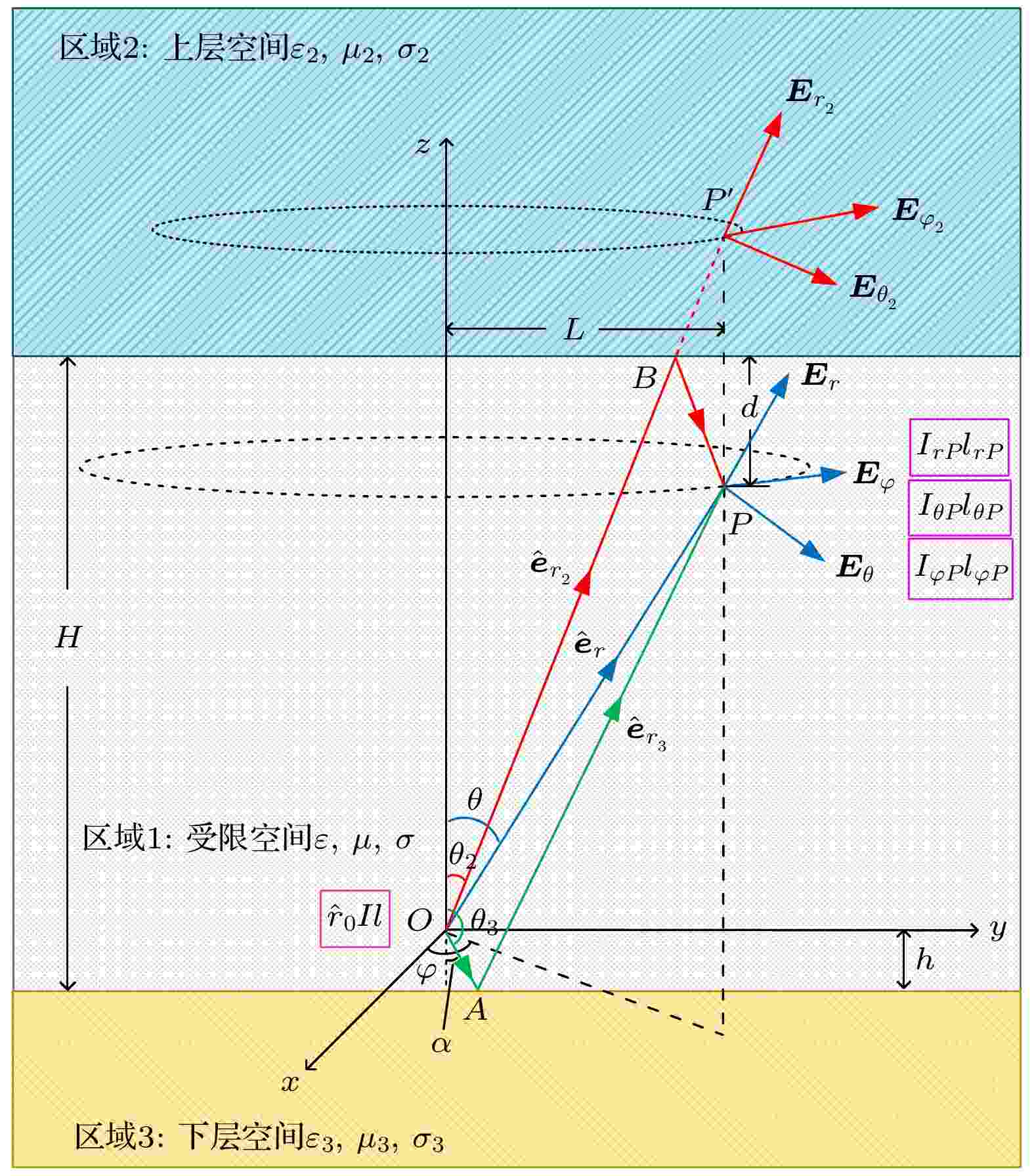
2022, 71 (20): 200301.
doi:10.7498/aps.71.20220545
Abstract +
The far-field calculation of arbitrarily oriented electric dipole in a stratified confined space is of great significance in analyzing electromagnetic properties in the lightning return stroke, submarine communication, over-the-horizon ground-wave radar, etc. Based on the mirror image method and the far-field approximation of an electric dipole in free space, a three-layer horizontal confined space model with an arbitrarily oriented dipole is established in this work. Through novel vector operations, the expression of the far field generated by an arbitrarily oriented electric dipole in the confined space model is derived, where the direct wave from the source point to the observation point and the waves reflected by the upper boundary and the lower boundary are all comprehensively considered. On this basis, the radiation characteristics of the electric dipole with frequencies of 100 kHz, 6 MHz and 10 MHz at different positions in the Earth-ionosphere waveguide are compared and analyzed, which are taken for example. Three different orientations of electric dipoles,i.e. vertical direction, horizontal direction, and 45º tilt are taken into account and the corresponding radiation patterns are presented. The results show that the radiation characteristics of electric dipoles in the Earth-ionosphere waveguide will change greatly with their frequencies, orientations and positions. For the electric dipole source at the same location, the higher the frequency, the more the number of radiation lobes is. In addition, when the source frequency keeps unchanged, the farther the dipole source is from the bottom boundary, the more the radiated lobes are. The proposed expression can conveniently and accurately consider the direct wave of a dipole source and its primary reflection from the upper interface and the lower interface in a confined space, and can also be further extended to solving the contribution of multiple reflections from the interfaces.
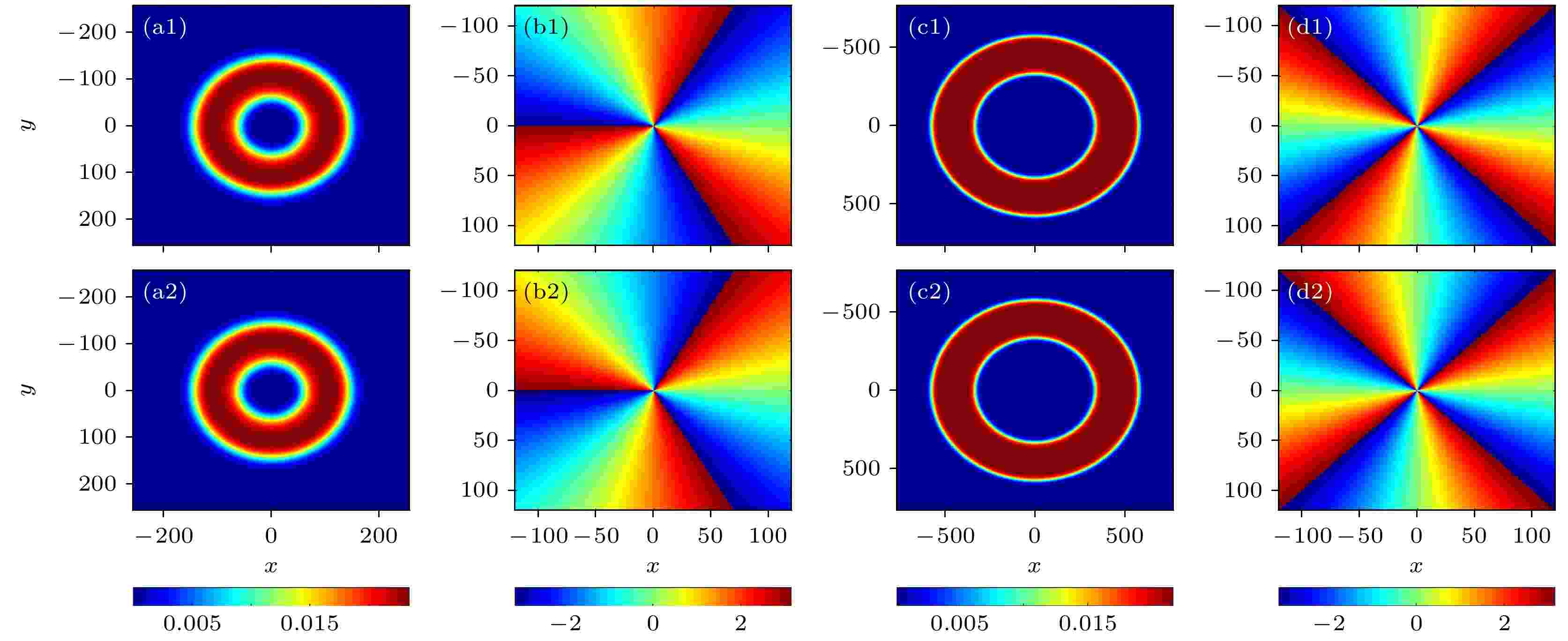
EDITOR'S SUGGESTION
2022, 71 (20): 200302.
doi:10.7498/aps.71.20220709
Abstract +
In this work, we study the quasi-two-dimensional hidden vortices of quantum droplets (QDs) trapped by a thicker transverse confinement and investigate their dynamical properties. Previous studies demonstrated that the hidden vortices of QDs in a three-dimensional free space are unstable and stable two-dimensional hidden vortices of QDs only with
${S_{1,2}} = \pm 1$
can be supported by a thin transverse confinement. Under the conditions of thicker transverse confinement, the Lee-Huang-Yang correction term in quasi-two-dimensional space is still described in the form of the three-dimensional space. Hence, under this condition, the stability and characteristics of the hidden vortices of QDs are worth studying. By using the imaginary time method, the hidden vortices of QDs with topological charge
${S_{1,2}}$
up to
$ \pm 4$
are obtained for the first time. Furthermore, the dependence of the effective area
${A_{{\text{eff}}}}$
and the chemical potential
$\mu $
on the total norm
$N$
of the hidden vortices of QDs are demonstrated. Besides, by using the linear stability analysis combined with the direct simulations, we obtain the dependence of the threshold norm
${N_{{\text{th}}}}$
on the topological charge
${S_1}$
and the nonlinear coefficient
${\text{δ}}g$
. Finally, we study the composite vortex pattern constructed by two hidden vortices of QDs, namely nested vortex QDs. Based on the fact that the hidden vortices of QDs generally have flat-top density profiles, the Thomas-Fermi approximation can be used to verify the numerical results effectively. The results of this paper can be extended in some directions, and provide a theoretical basis for the experimental realization of the hidden vortices of QDs.
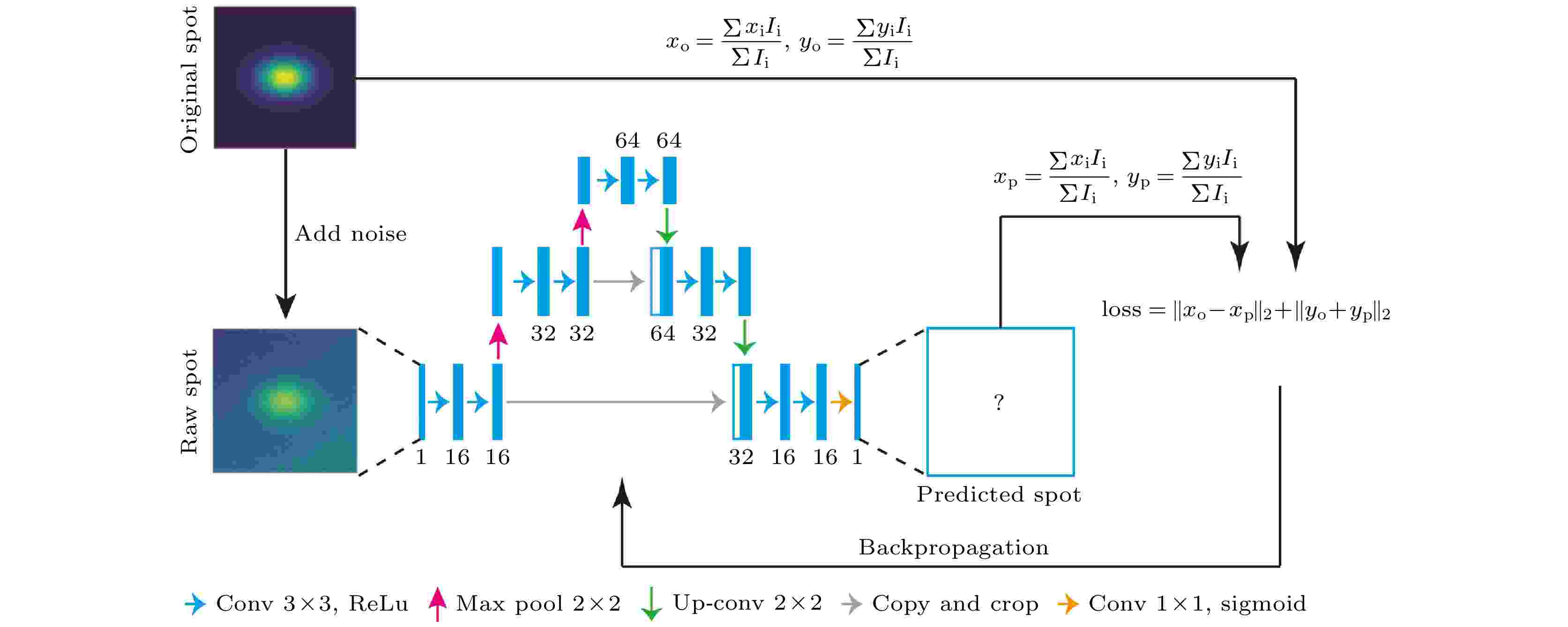
2022, 71 (20): 200601.
doi:10.7498/aps.71.20220670
Abstract +
To determine the centroid of far-field laser beam spot with high precision and accuracy under intense noise contamination, a positioning algorithm named centroid-PINN is proposed, which is based on physical information neural network. A U-Net neural network is utilized to optimize the centroid estimation error. In order to demonstrate this new method, Gaussian spots polluted by two kinds of noises, i.e. ramp noise and white noise, are generated by simulation to train the neural network. The neural network is tested by two kinds of spots, i.e. Gaussian spot and Sinc-like spot. Both are predicted with high accuracy. Compared with traditional centroid method, the centroid-PINN needs no parameter tuning, especially can cope with ramp noise interference with high accuracy. This work will be conducive to developing the far-field laser beam spot measurement device, and can also serve as a reference for developing the Shack-Hartmann wavefront sensor.

2022, 71 (20): 200701.
doi:10.7498/aps.71.20220611
Abstract +
In a distributed fiber optic temperature sensing system, the intensity of Raman Stokes backscattering light serving as reference light increases with the increase of temperature, leading to measurement errors in the system. A novel method of dynamically calibrating Raman Stokes backscattering light intensity is proposed to improve temperature accuracy for distributed fiber optic temperature sensors. According to the real-time Stokes intensity distribution in the reference fiber, Stokes intensity curve of the whole fiber at a reference temperature is simulated, and the temperature response of Stokes light is corrected. The ratio of Raman anti-Stokes light intensity to the calculated Stokes light intensity is used to demodulate temperature along the fiber. The experimental results indicate that the temperature accuracy of the distributed optical fiber temperature sensor system after making the Stokes optical dynamic calibration is increased up to 4.3 ℃ compared with that from the conventional method. And the accuracy of temperature measurement is improved by 8.9 ℃ when combined with Rayleigh noise suppression method. This study provides a new solution for a distributed fiber optic temperature sensor system to monitor high temperature environment temperature.

2022, 71 (20): 200702.
doi:10.7498/aps.71.20221112
Abstract +
An accumulation model of X-ray and debris in a high altitude nuclear explosion is built in this work. Using the established model, we simulate the energy accumulations of four large scale experiments (i.e. the Checkmate, Starfish, K3 and K4) conducted by the United States and the Soviet Union. The dynamics of the kinetic accumulation at 100–200 km altitude is analyzed. Our simulation results show that the kinetic patch spreads a relatively small spatial region and has a large energy density compared with the X-ray patch. The accumulation of the debris ions can be finished within around 0.5 s, and two absorption peaks (hence two kinetic patches) can be observed at an altitude of about 115 km and the burst point. The shape of the kinetic region projected onto the horizontal plane is roughly elliptical, the eccentricity will be smaller at higher latitudes, and the area will be larger at higher altitudes. Away from the bursting point, the maximum energy density of the kinetic patch is near the magnetic field line that crosses the bursting point. Within the magnetic bubble, the maximum energy density of the kinetic patch occurs near the bursting point.
ATOMIC AND MOLECULAR PHYSICS
EDITOR'S SUGGESTION
2022, 71 (20): 203101.
doi:10.7498/aps.71.20220923
Abstract +
The Fermi contact term is closely related to the atomic hyperfine constants. It often dominates the hyperfine splittings. The quality of the wave function near the origin and the correlation effect between electrons are two main factors which affect the numerical accuracy of the Fermi contact term. It is not an easy task to compute the Fermi contact term with high precision for a general atom. In the present paper, the Schrödinger equations of the
$ {\text{1s2s3s}}{\;^{\text{4}}}{\text{S}} $
,
$ {\text{1s2s4s}}{\;^{\text{4}}}{\text{S}} $
and
$ {\text{1s2s2p}}{\;^{\text{4}}}{\text{P}} $
states of lithium atom and lithium-like ions (Z= 4–10) are solved by using Rayleigh-Ritz variational method in Hylleraas coordinates. The variational energiesenergy converges to an accuracy of 10–13. Then the Fermi contact terms for these states are calculated based on the high precision variation wave functions. In particular, the Drachman global method are adopted in order to improve the convergence of the Fermi contact term. The effect of finite nuclear mass on Fermi contact term, i.e. the first-order mass polarization coefficient is also calculated. The Fermi contact term converges to an accuracy of 10–10, which is the most accurate result at present. Our results can be used as a reference for other theoretical methods or relevant experimental studies.
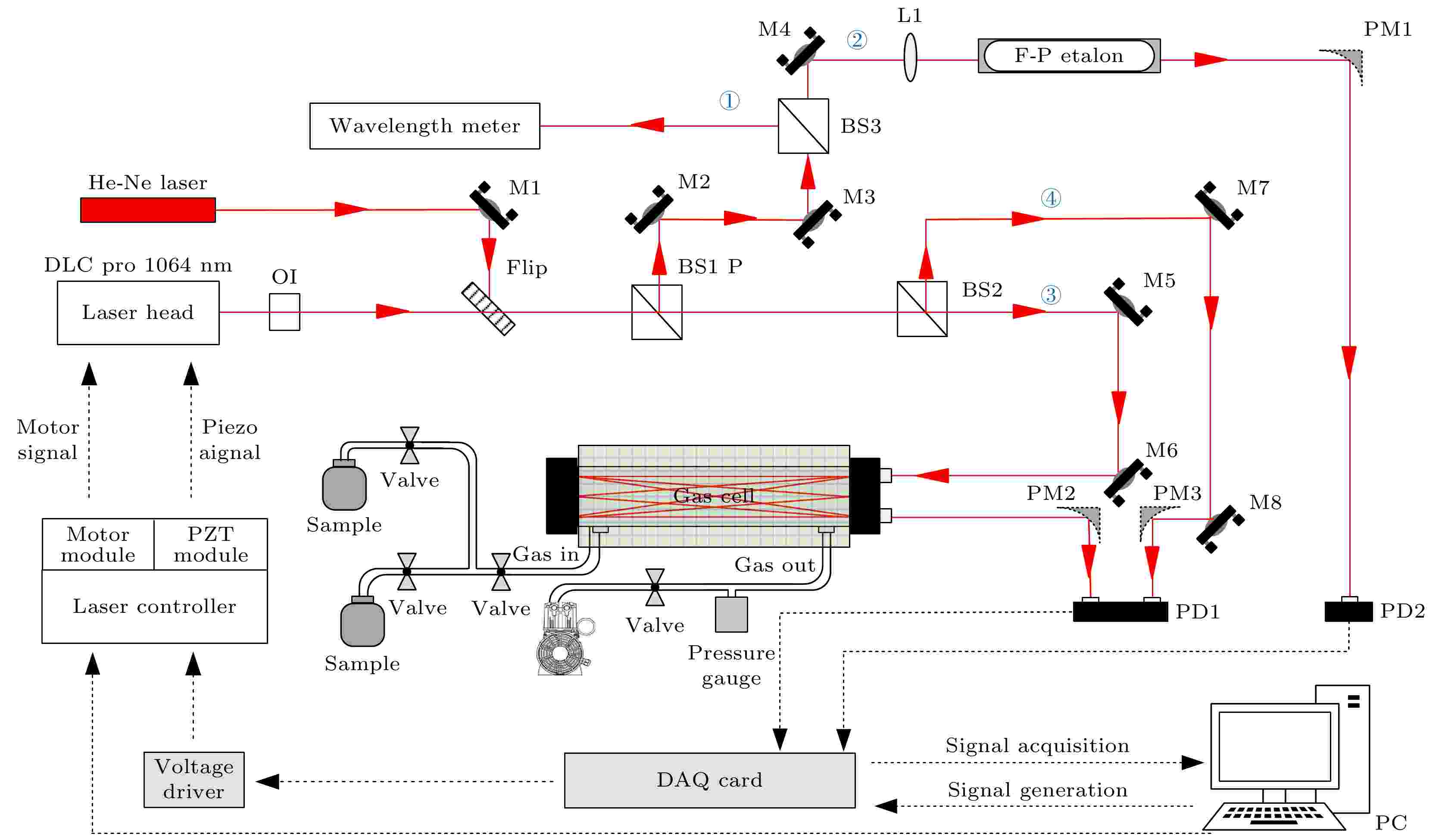
2022, 71 (20): 203301.
doi:10.7498/aps.71.20220700
Abstract +
The absorption spectral parameters of water vapor molecules are the key basic scientific data for the remote sensing detection and the planetary observation applications. Based on a narrow line-width external cavity diode laser and a long-path absorption cell, 18 absorption spectral lines of CO2-broadened water vapor molecules in a 9332–9722 cm–1range at room temperature are measured. To obtain the CO2-broadened water vapor molecule coefficients, the Voigt profile and the quadratic speed-dependent Voigt profile are used to fit the absorption spectrum data. The quadratic speed-dependent Voigt profile shows better fitting capability. Comparing with the air-broadened coefficients of the corresponding region from the HITRAN2020 database, the mean ratios of the CO2-broadened coefficients of water vapor molecules and the air-broadened coefficients obtained from the two models of the line shape are 1.327 and 1.454, respectively, which verifies that the method of estimating the CO2-broadened coefficient by the air-broadened coefficient of water vapor molecules has certain reliability. This study can provide reference data of measured spectral parameters for the detection technology and related research of atmospheric structures of Mars and Venus in the near-infrared region.
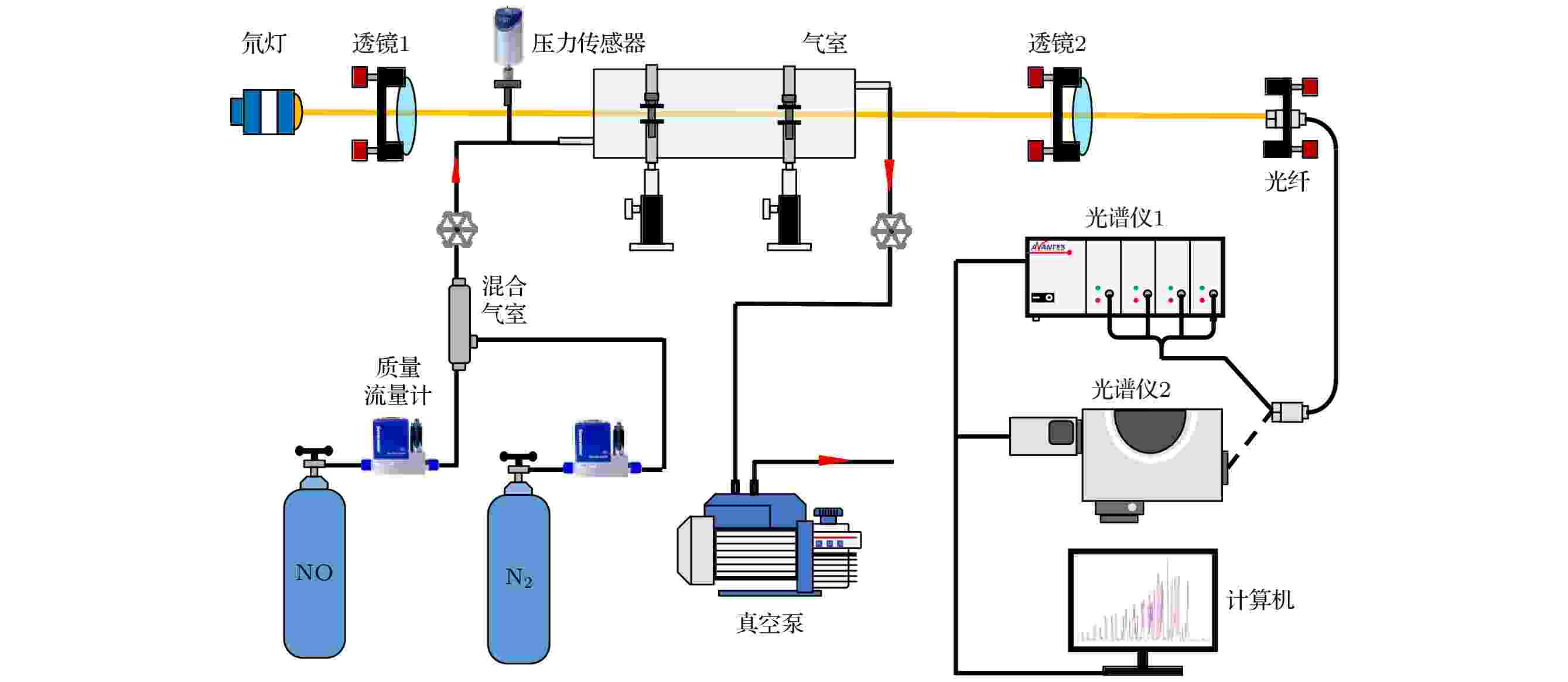
COVER ARTICLE
2022, 71 (20): 203302.
doi:10.7498/aps.71.20220975
Abstract +
Ultraviolet broadband absorption spectroscopy (UV-BAS) has been widely used to measure the concentration of gas pollutant, such as NO. However, the nonlinear dependence of the absorbance on the optical thickness (XL) caused by the broadening effect of instrument function is observed. In this paper, the nonlinear behavior of NO absorbance is investigated both theoretically and experimentally, and a database using a polynomial to describe the nonlinearity is established to present a simple method of measuring NO concentration. First, the nonlinear relationship between absorbance andXLis deduced. Second, the nonlinearity of an isolated spectral line is simulated, and the dependence of nonlinear behavior on instrument width is investigated. Third, the nonlinerities of peak absorbance inγ(0, 0) band with different instrumental widths are calculated, the nonlinear expression is given in a polynomial form, and the corresponding coefficient database is established. In addition, the nonlinearities in different vibration bands with the same instrumental width are compared with each other. Finally, two spectrometers are used to measure NO absorption spectra in different instrumental widths in order to validate the above-mentioned results of theoretical analysis. The relative error between the measured peak absorbance and theoretical calculation is less than 4%, and that between experimental results and the interpolation polynomial results is less than 8%. The experimental results demonstrate the accuracy of theoretical calculation and the reliability of database.
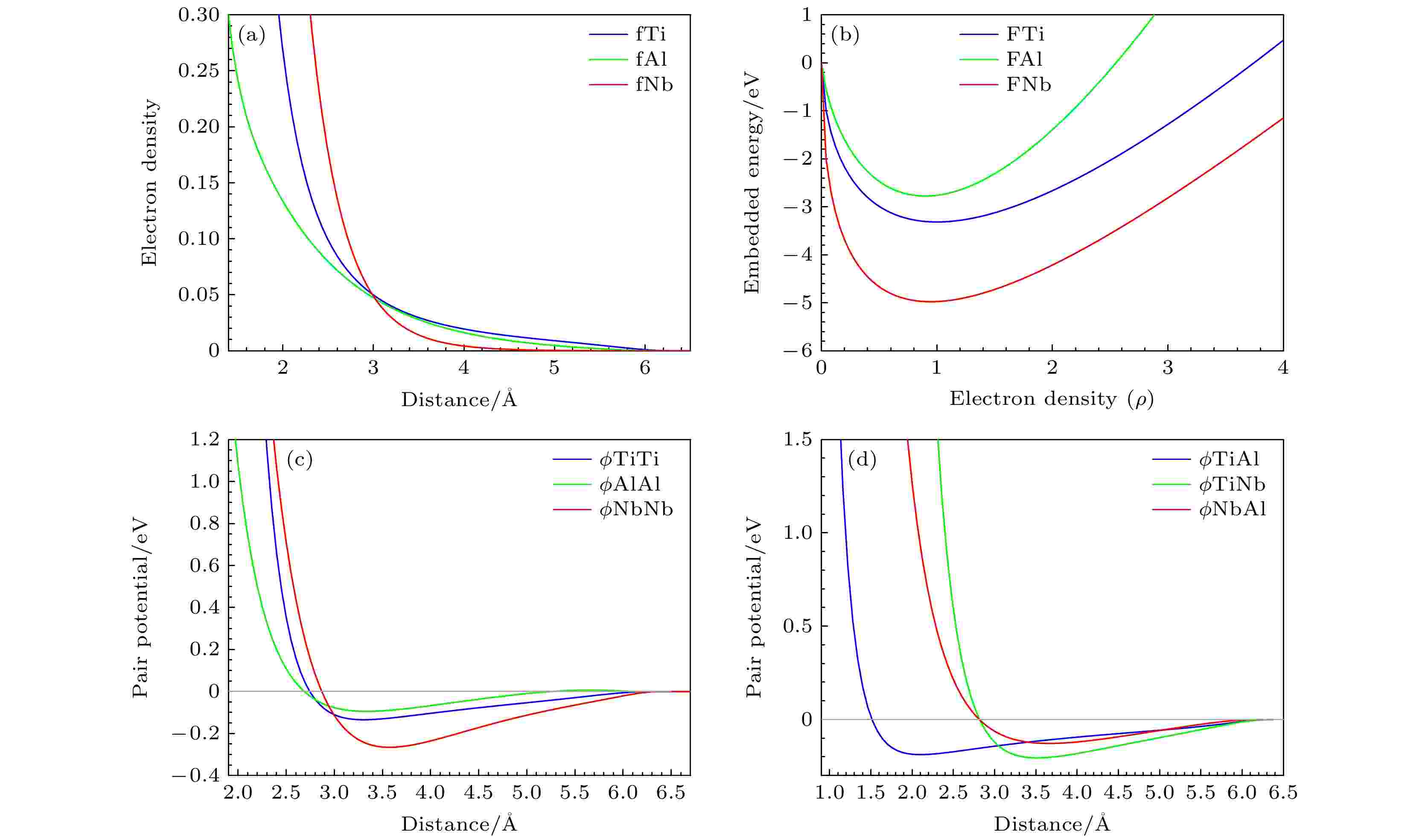
2022, 71 (20): 203401.
doi:10.7498/aps.71.20220846
Abstract +
Molecular dynamics simulation is an effective computer simulation method. However, owing to the lack of suitable interatomic potential of multicomponent alloys, the application of molecular dynamics simulation is limited. The development of interatomic potential of multicomponent alloys has always been challenging. In this work, under the framework of EAM model, a construction method of interatomic potential suitable for ternary ordered alloys is proposed, and a new interatomic potential of Ti2AlNb alloys suitable for atomic-scale mechanical behavior simulation is developed. The potential can well reproduce the elastic constants of B2-Ti2AlNb, unrelaxation vacancy formation energy, substitutional atom formation energy, transposition atom formation energy, surface energy and cohesive energy of three ordered phase (B2, D019and O phases ) in different volumes. To further test the potential functions, 1) theE-Vcurve of B2 phase is calculated, and the result is well consistent with Rose curve; 2) the melting transformation process of B2 phase is studied by molecular dynamics simulation, and the results roughly reflect the experimental fact. The present work provides a way to develop the interatomic potential of multicomponent alloys, and a option for the workers who simulate and calculate the Ti2AlNb alloys as well.
ELECTROMAGNETISM, OPTICS, ACOUSTICS, HEAT TRANSFER, CLASSICAL MECHANICS, AND FLUID DYNAMICS

2022, 71 (20): 204201.
doi:10.7498/aps.71.20220739
Abstract +
The single-photon source in mid-infrared (MIR) band is very important for the next generation of quantum sensing, quantum communication and quantum imaging. At present, the commonly used method of generating MIR single-photon source is based on the spontaneous parametric down conversion (SPDC) process in the periodically poled lithium niobate (PPLN) crystal. However, the spectral purity of single-photon source based on the ordinary PPLN is not high, specifically, its maximum value is only about 0.82, which affects the fidelity of quantum information processing scheme. In this paper, 4000 polarized domains in a 30-mm-long LN crystal are customized by using the domain design theory. The sidelobes in the phase matching function are eliminated, and the Gaussian distribution is obtained. The calculated spectral purity of the single-photon source can reach 0.99, and its tunable range is 2.7–3.3 μm. The customized poled lithium niobate (CPLN) is expected to provide a single-photon source with excellent performance for the study of quantum information in the MIR band.
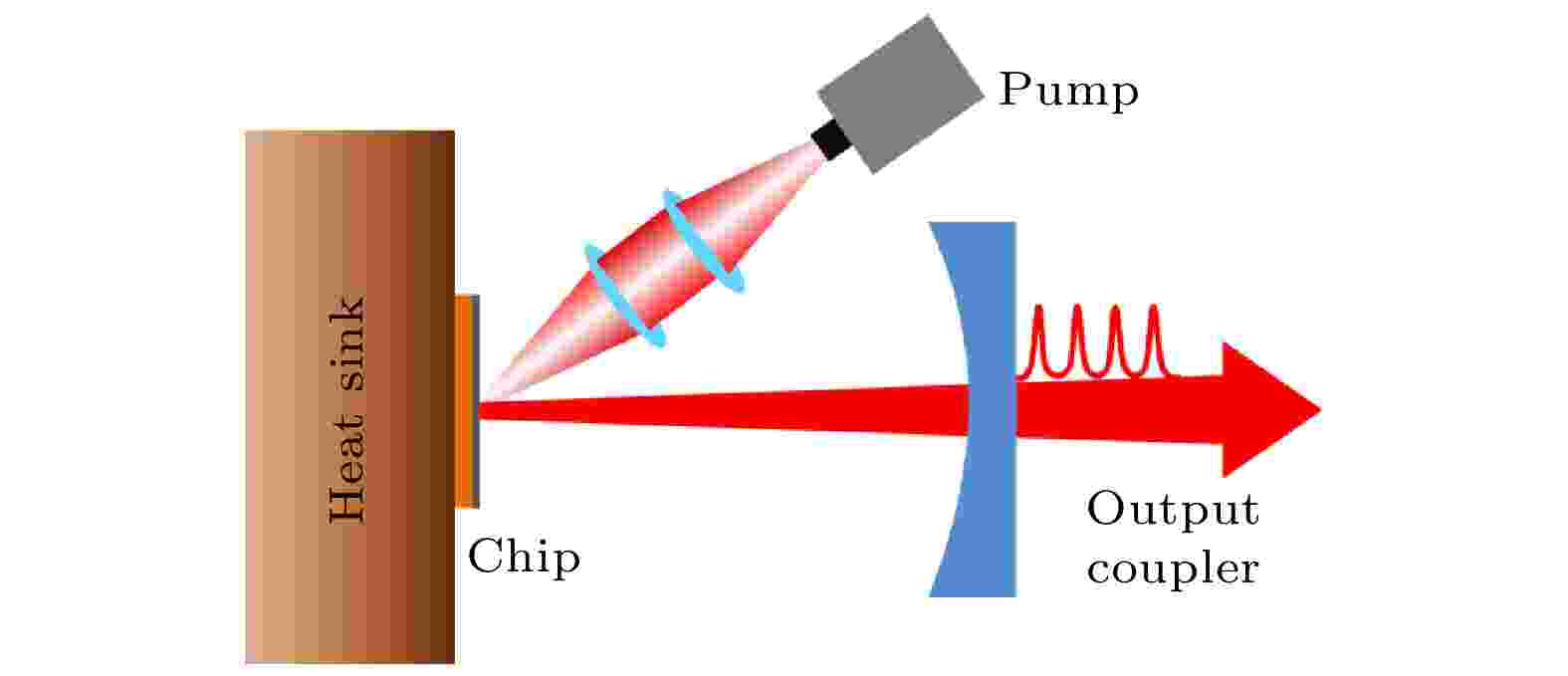
EDITOR'S SUGGESTION
2022, 71 (20): 204202.
doi:10.7498/aps.71.20220483
Abstract +
Dual-wavelength mode-locked lasers can be widely used in optical communication, pump-probe experiment, nonlinear frequency conversion, etc. In this paper, a dual-wavelength self-mode-locked semiconductor disk laser is reported for the first time, to the best of our knowledge. A simple linear resonator is formed by using a high reflectivity distributed Bragg reflector at the bottom of the gain chip, and an external output mirror; the cavity length is about 135 mm, with no need of additional inserted elements. Based on the Kerr effect of the gain medium and the soft aperture formed by the pump spot on the gain chip, along with the fine adjustment of cavity length and pump intensity, the mode-locking process can be started from the free running and the stable self-mode-locking can be realized. The mode-locked pulse width is 4.3 ps, the repetition rate is 1.1 GHz, and the maximum output power is 323.9 mW, which corresponds to a peak power of 68 W. After the laser is mode locked, a readily available blade, which can introduce a wavelength-dependent loss for different laser modes, resulting in a lager cavity loss for a longer-wavelength mode and a smaller cavity loss for a shorter-wavelength mode, is used as a wavelength tuning element, and is inserted into the cavity in the direction perpendicular to the optical axis of the resonator. By changing the depth of the blade inserted into the cavity, the laser wavelength can be continuously tuned from the initial oscillating wavelength (longer-wavelength) to a shorter wavelength, a stable dual-wavelength output with equal intensity can be obtained at a specific position, and the stable continuous-wave mode-locking can be maintained simultaneously. The steady dual-wavelengths in the experiment are 951 and 961 nm, and the corresponding output power is 32 mW. The above dual-wavelength outputs have good coherence since they are stimulated radiations from the same gain chip. Meanwhile, they have relatively high peak power and strictly meet the coaxial conditions, and these are all advantages for the difference frequency generation (DFG). The frequency of the DFG in the experiment is approximately 3.3 THz, which can be widely used in laser radar, remote sensing, homeland security, counter-terrorism, atmospheric and environmental monitoring and otherareas.

2022, 71 (20): 204203.
doi:10.7498/aps.71.20220888
Abstract +
Aiming at three-dimensional (3D) sensing applications such as LiDAR, high power density five-junction cascaded vertical cavity surface emitting lasers (VCSELs) with 905 nm wavelength are designed and fabricated. The maximum power conversion efficiency is 55.2% for an individual VCSEL emitter with 8 μm oxide aperture. And the maximum slope efficiency of the device is 5.4 W/A, which is approximately 5 times that of traditional single-junction VCSEL with the same aperture. Under the condition of narrow pulse (pulse width 5.4 ns, duty cycle 0.019%) injection, the peak output power of 19-element array (20 μm oxidation aperture for each element) reaches 58.3 W, and the corresponding power density is as high as 1.62 kW/mm2. The devices with various apertures (8–20 μm) are characterized. The results show that the maximum slope efficiencies of all these devices are greater than 5.4 W/A and the maximum PCE is higher than 54%. These high-performance VCSEL devices can be used as ideal light sources for 3D sensing applications such as LiDAR.

2022, 71 (20): 204204.
doi:10.7498/aps.71.20220703
Abstract +
The phase-preserving amplitude regeneration scheme based on the bidirectional orthogonal-pumped semiconductor optical amplifier (SOA) is proposed in this work. Experimental investigation into the multiple four-wave mixing (FWM) process from the pump, the signal and their corresponding reflective fields is carried out in detail. The regeneration performance obtained from the product between co-propagating fields is also discussed, including its dependence on the signal launch power and the signal quality, to quantify the amplitude regeneration and the phase preserving behaviors. The amplitude distortion is suppressed by 2.2 dB experimentally, confirming the regeneration capability of the proposed scheme. Moreover, the regeneration performance is further investigated for multiple phase shift keying (MPSK) signals through the simulation. According to the numerical results, the operational parameters of the regenerator are the same for advanced modulation formats, proving the robust operation of the proposed bidirectional orthogonal-pumped SOA configuration.
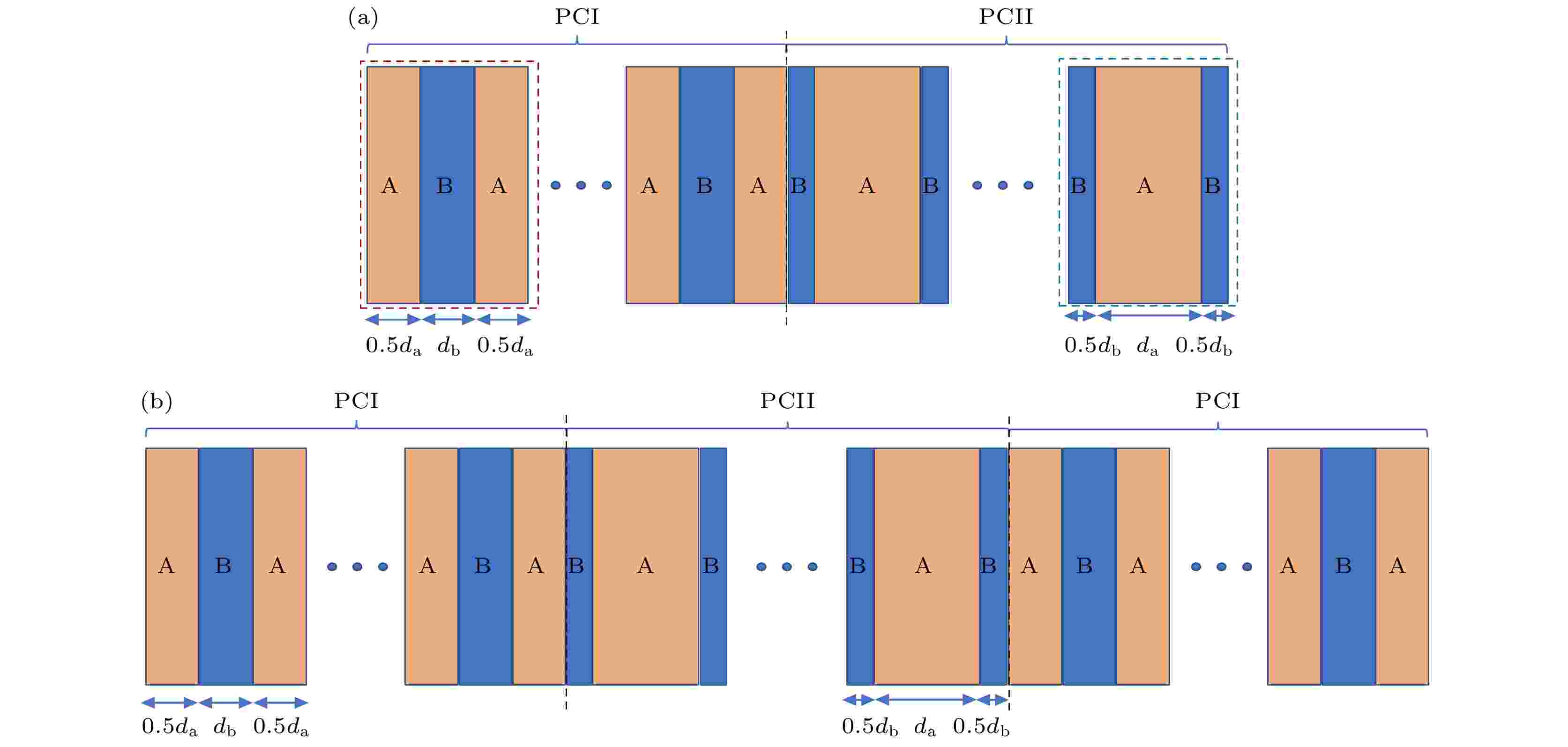
2022, 71 (20): 204205.
doi:10.7498/aps.71.20220383
Abstract +
Using the transfer matrix method, the tunable characteristics of the interface state generated by one-dimensional photonic structure with inversion symmetry are studied, and the samples are prepared by electron beam evaporation technology for experimental verification. According to the different inversion symmetry centers of unit cell, the inverted symmetric layered photonic structures are divided into two types i.e. PCI and PCII. The calculation results show that for the combined structure composed of PCI and PCII, there is an interface state at a characteristic frequency where the sum of the imaginary parts of the surface impedance of PCI and PCII is equal to zero, and this frequency of the interface state is independent of the number of unit cells. On this basis, if a PCI structure is added to form PCI + PCII + PCI photonic structure, two interface states will be generated in the same band gap, and changing the unit cell number in each or part of of individual PCI and PCII structures, the frequencies of two interface states can be regulated. The experimental results show that the regulation of interface state by controlling unit cell number is feasible, which provides a more flexible idea for designing the extremely narrow-band filters and multi-channel filters to meet different application requirements.
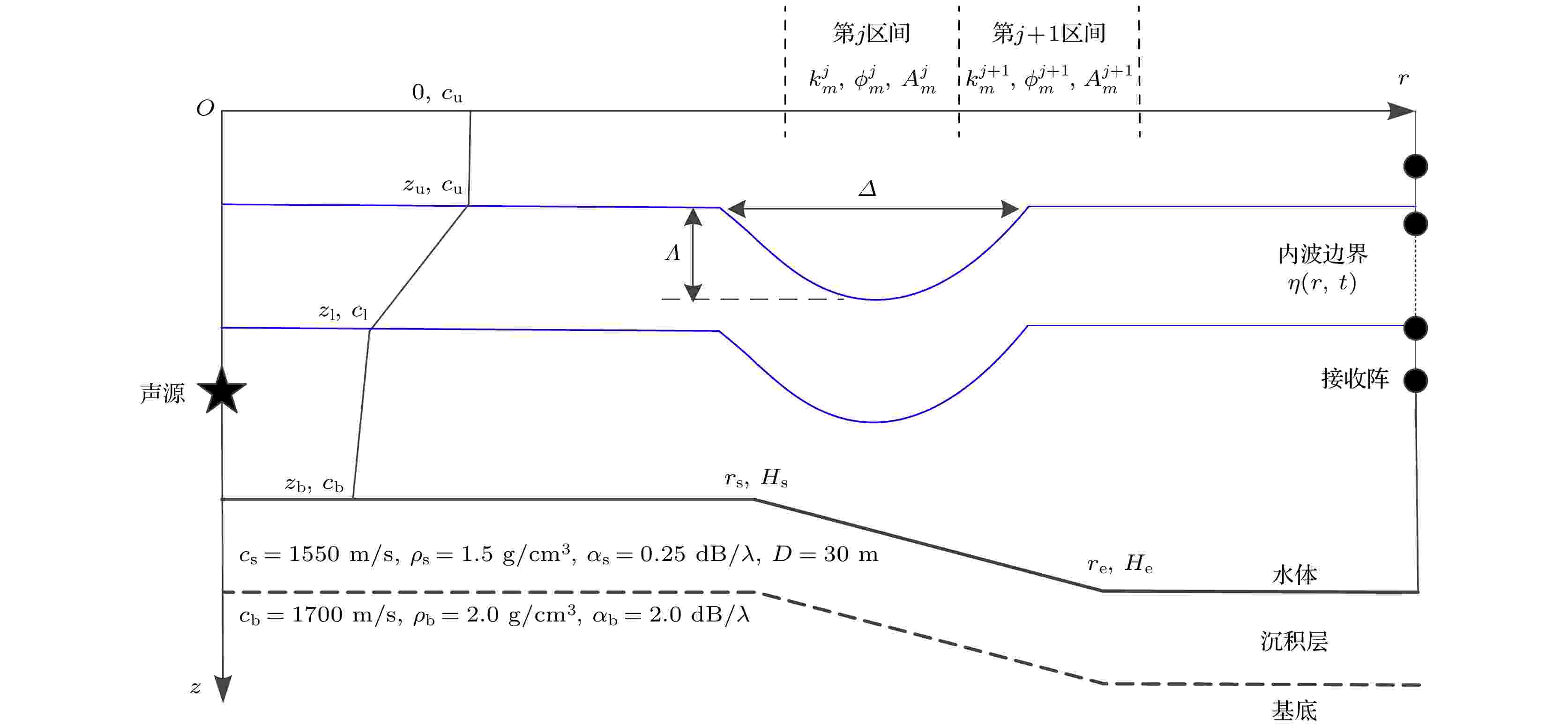
2022, 71 (20): 204301.
doi:10.7498/aps.71.20220634
Abstract +
The topographic variation underwater of the continental slope is one of the main causes for triggering off the formation of internal waves, and the continental slope internal waves are ubiquitous in the ocean. The horizontal variation of waveguide environment, caused by the internal wave and the continental slope, can lead to acoustic normal mode coupling, and then generate sound field fluctuation. Most of the existing research work focused on studying the effect of single perturbation factor of either the internal waves or the continental slope on acoustic mode coupling and intensity fluctuation, while it is hard to find some research work that takes into account both the internal waves and the topographic variations as influencing factors. In this work, numerical simulations for the sound waves to propagate through the internal waves in the downhill direction are performed by using the acoustic coupled normal-mode model in four waveguide environments: thermocline, internal wave, continental slope and continental slope internal wave. And the mode coupling and intensity fluctuation characteristics and their physical mechanisms are studied by comparing and analyzing the simulation results of the four different waveguide environment constructed. Some conclusions are obtained as follows. The intra-mode conduction coefficients are symmetric with respect to the center of the internal wave, while the inter-mode coupling coefficients are antisymmetric around it. As the sound waves propagate toward or away from the center of the internal wave, the acoustic mode coupling becomes enhanced or weakened, and the coupling coefficients curves for large mode oscillate. The influence of internal wave perturbation makes the energy transfer from the smaller modes to the larger modes, which increases the attenuation of sound field intensity. The number of the waveguide modes increases and the mode intensity attenuation decreases, when the sound waves propagate downhill. The total intensity of all modes for the continental slope internal wave environment is greater than for the internal wave environment and less than for the continental environment, and the energy transfer between mode groups is stronger than for individual effect of internal wave or continental slope, which leads more energy to transfer from the smaller to larger mode groups and the energy of the sound field above the thermocline to increase.
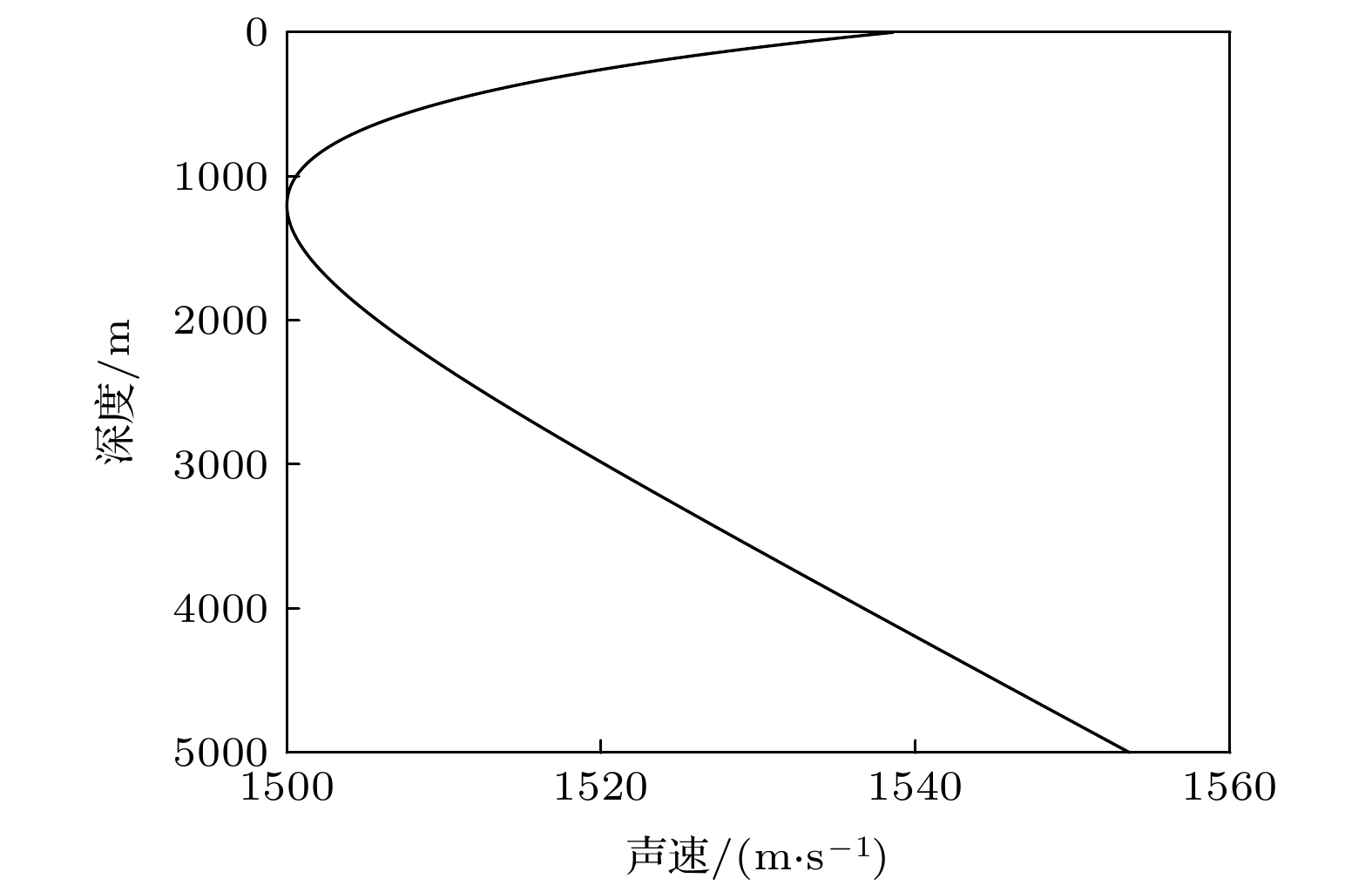
2022, 71 (20): 204302.
doi:10.7498/aps.71.20220763
Abstract +
The constant phase shift
$- {{\text{π}}}/{2}$
generated by a turning point is an ideal approximation under high frequency conditions. In fact, when sound waves pass through a turning point, it will travel horizontally for a certain distance in the form of inhomogeneous plane wave and then be refracted back. At this time, a functional phase shift should also be included at the turning point. In addition, a refracted ray will bring about reflection phase shift when the turning point is close to the waveguide edge. These two kinds of phase shifts which are associated with the diffraction phenomenon are called diffraction phase shifts in this paper and are more notable when the frequency goes down. In order to accurately obtain the caustic structure at low frequency, the diffraction phase shift is used to correct the classical ray theory in calculating ray skip distance, traveling time, and group velocity in this work. On this basis, a simple and explicit analytical model is proposed which is suitable for calculating the low frequency deep water caustics. The numerical study of the first upper convergence zone in the complete deep water sound channel shows that there are three caustic lines in the refracted-refracted (RR) convergence zone and four caustic lines in the refracted surface-reflected (RSR) convergence zone under the condition of high frequency hypothesis. When the diffraction phase shifts at low frequency are included, and compares with high frequency results, it is found that the horizontal beam displacement caused by the reflection phase shift will make the RR caustics horizontally move towards the source and also lead the RSR rays to generate several new caustics, while the beam displacement caused by sound propagating in the form of inhomogeneous plan wave will make the RR caustics horizontally move away from the sound source. Accompanied with the increased frequency, the diffraction effect will decrease, and the caustic structure gradually tends to the classical ray theory results. The reliability of the correction results is verified by the normal mode theory. The model proposed in this work makes up for the deficiency of classical ray theory.
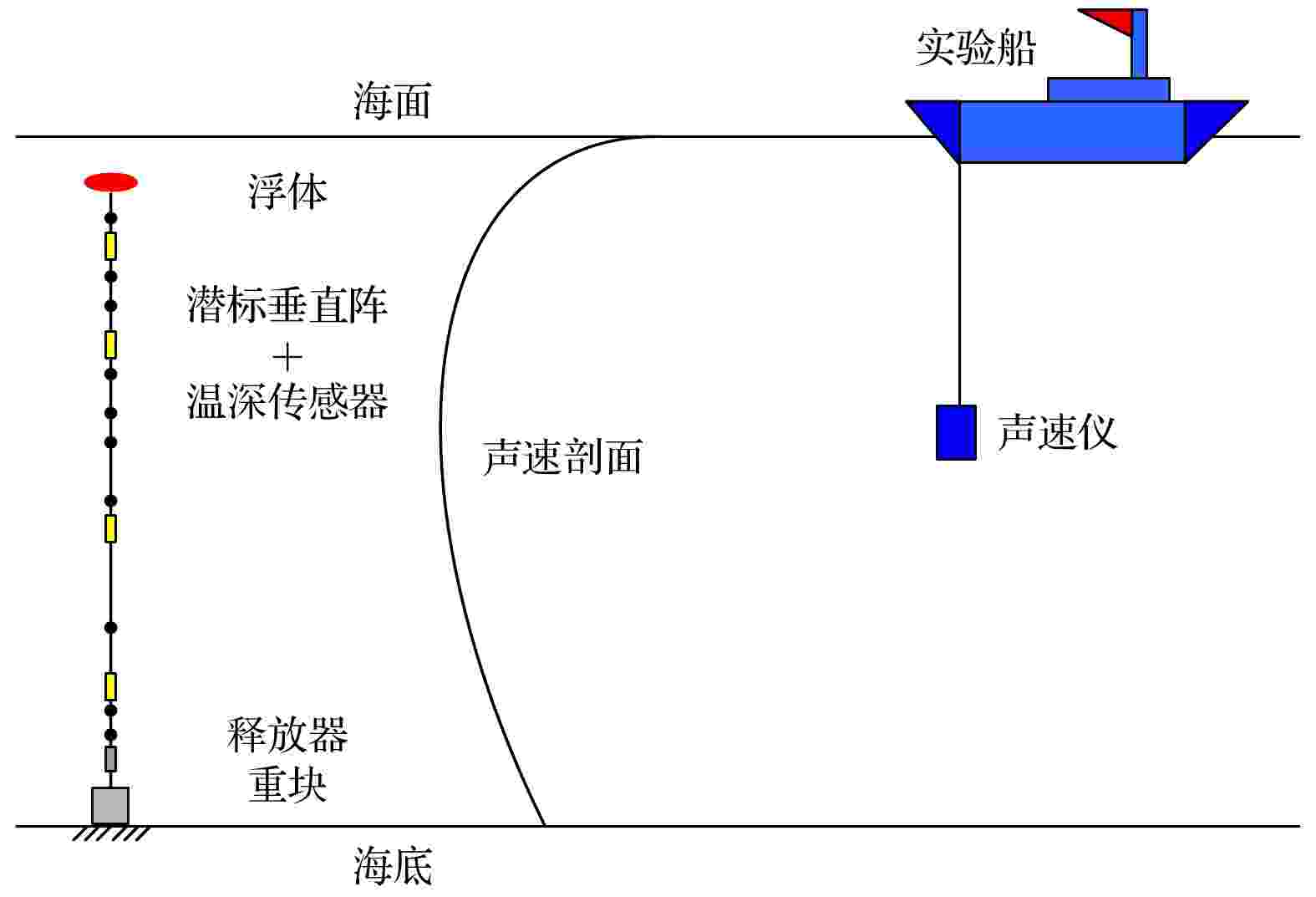
2022, 71 (20): 204303.
doi:10.7498/aps.71.20220615
Abstract +
The wind speed and rainfall rate above the sea surface have significant effects on the ocean ambient noise, and the noise level can be predicted by using the ocean ambient noise model combined with wind speed and rainfall rate parameters. In this work, we study the ambient noise characteristics in the East Indian Ocean and analyze the influences of wind speed and rainfall rate on the ocean ambient noise. The results show that the correlation coefficient between high-band noise level and wind speed could reach 0.59 in the absence of rainfall, that the correlation coefficient between high-band noise level and rainfall rate can reach 0.85 in the presence of rainfall, and that the strong rainfall can increase the high-band ambient noise level by more than 6 dB. The wind-generated noise source level formula is also modified to make it applicable to the deep-sea environment of the East Indian Ocean, and the overall error between the model prediction of noise intensity level and the experimental noise intensity level in intense rainfall is within 2 dB after the modification. When the model is validated by using small-scale rainfall noise data, it is found that the noise source model using a non-uniform rainfall noise source at the sea surface during small-scale rainfall is more accurate than using a uniform rainfall noise source. The modified prediction model of wind-generated and rain-generated noise is important for predicting the ocean-ambient-noise characteristics in the Indian Ocean.
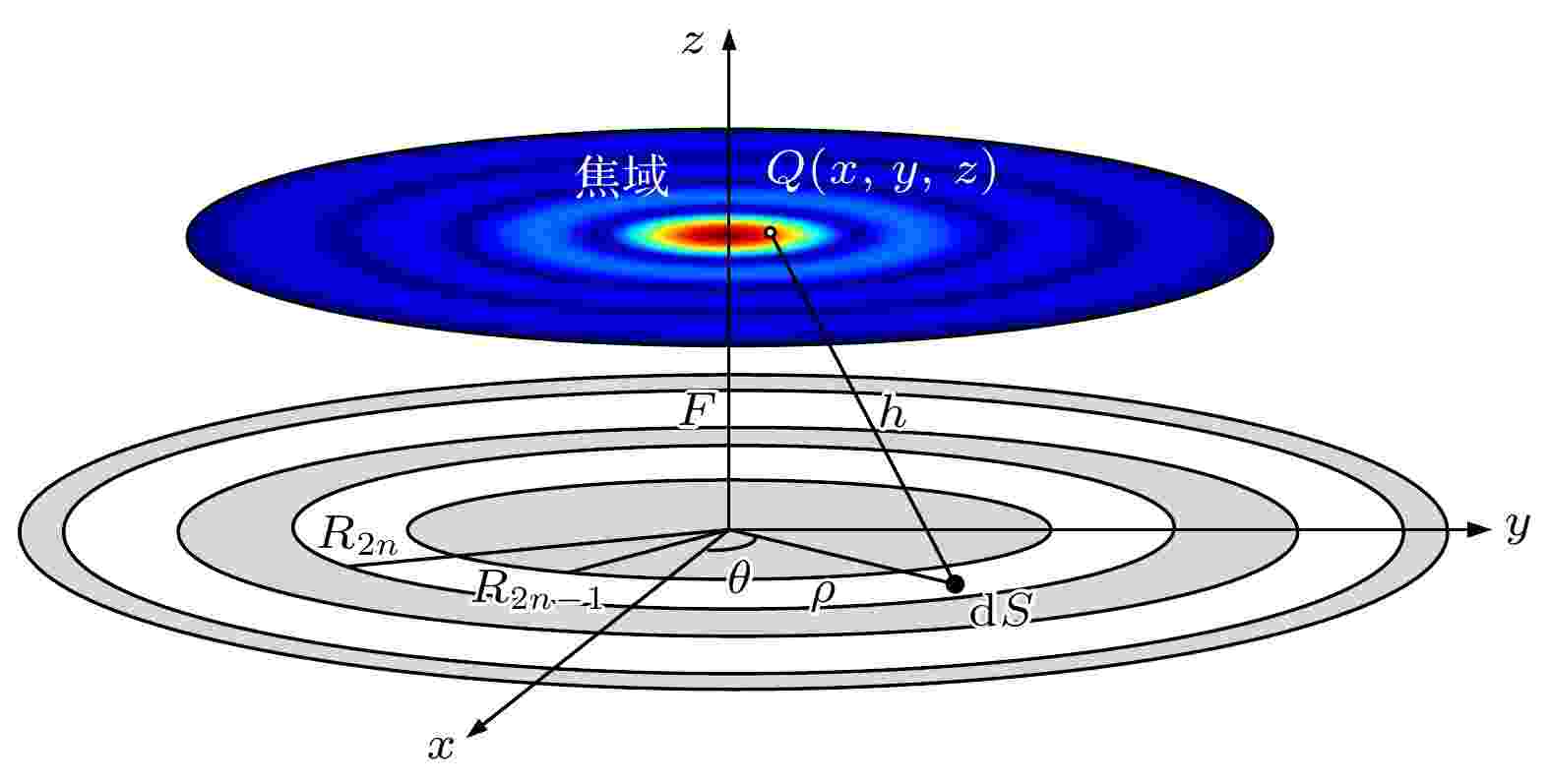
2022, 71 (20): 204304.
doi:10.7498/aps.71.20220898
Abstract +
The spatial resolution of conventional waves is restricted by the diffraction limit of half wavelength. Hence, how to construct super-resolution acoustic beams with a smaller focal radius is one of the major challenges in recent studies. In the present paper, the super-resolution acoustic focusing method is proposed based on the superposition of multi-frequency super-oscillation beams and the Particle Swarm Optimization (PSO), which can improve the spatial resolution concurrently with good controllability. Based on the diffraction effect of traditional ultrasound fields, the acoustic lens of Fresnel zone plane (FZP) at the center frequency is designed by the half-wave zone method. Multiple acoustic beams at several preset frequencies within the transducer bandwidth are sent out to build the super-oscillation focal area by the pressure superposition. The radius of the super-resolution focal spot constructed by the PSO algorithm with optimized amplitudes and phases is less than the half wavelength at the center frequency, which is even smaller than the focal radius at the highest frequency. Furthermore, the focal radius is also proved to decrease with the increase of the number of multiple frequencies and the center frequency. The favorable results demonstrate the feasibility of super-resolution acoustic focusing based on the PSO of super-oscillation, and provide an applicable strategy for the high-resolution acoustic imaging and manipulation.
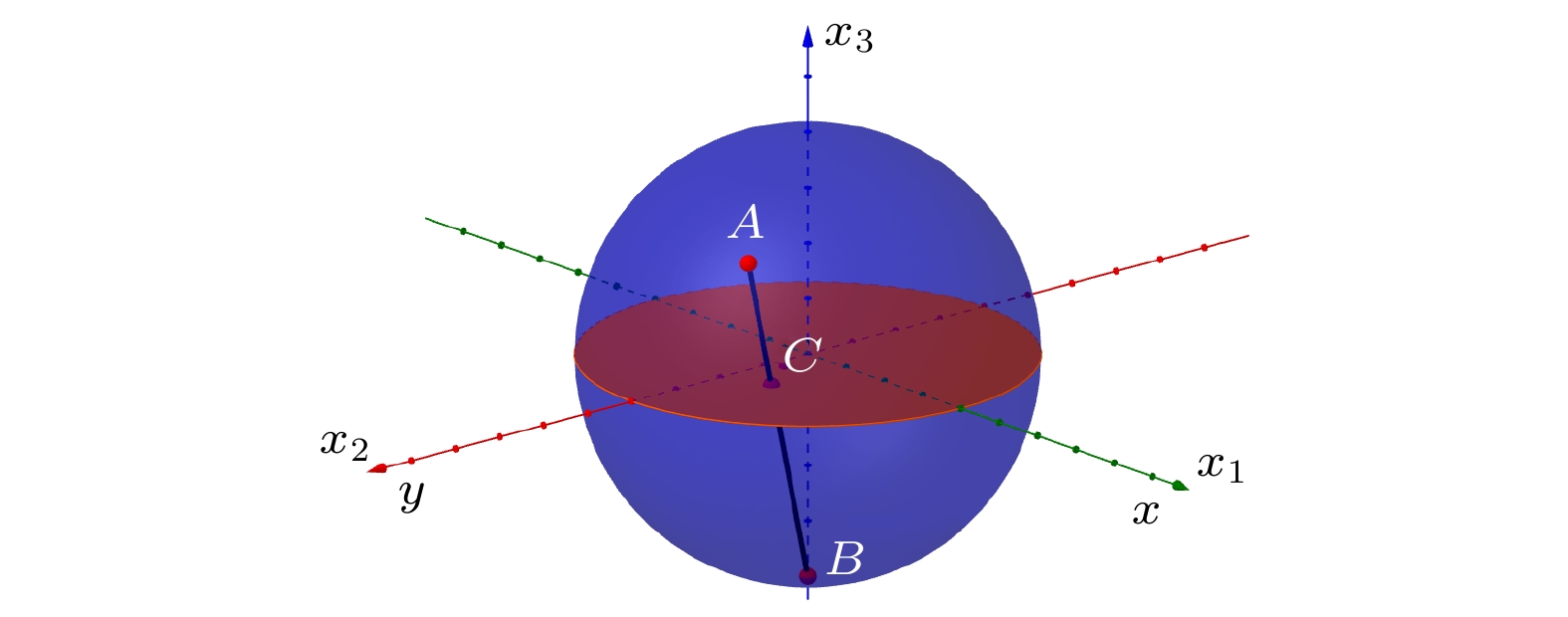
2022, 71 (20): 204701.
doi:10.7498/aps.71.20220693
Abstract +
The soap bubble heated at the bottom is a novel thermal convection cell, which has the inherent spherical surface and quasi two-dimensional features, so that it can provide an insight into the complex physical mechanism of the planetary or atomspherical flows. This paper analyses the turbulent thermal convection on the soap bubble and addresses the properties including the thermal layer and the viscous boundary layer, the thermal dissipation and the kinetic dissipation by direct numerical simulation (DNS). The thermal dissipation and the kinetic dissipation are mostly occur in the boundary layers. They reveal the great significance of the boundary layers in the process of the energy absorption. By considering the complex characteristics of the heated bubble, this study proposes a new definition to identify the thermal boundary layer and viscous boundary layer. The thermal boundary layer thickness of
$\delta_{T}$
is defined as the geodetic distance between the equator of the bubble and the latitude at which the the mean square root temperature (
$T^{*}$
) reaches a maximum value. On the other hand, the viscous boundary layer thickness
$\delta_{u}$
is the geodetic distance from the equator at the latitude where the extrapolation for the linear part of the mean square root turbulent latitude velocity (
$u^{*}_{\theta}$
) meets its maximum value. It is found that
$\delta_{T}$
and
$\delta_{u}$
both have a power-law dependence on the Rayleigh number. For the bubble, the scaling coefficent of
$\delta_{T}$
is
$-0.32$
which is consistent with that from the Rayleigh-Bénard convection model. The rotation does not affect the scaling coefficent of
$\delta_{T}$
. On the other hand, the scaling coefficent of
$\delta_{u}$
equals
$-0.20$
and is different from that given by the Rayleigh-Bénard convection model. The weak rotation does not change the coefficent while the strong rotation makes it increase to
$-0.14$
. The profile of
$T^{*}$
satisfies the scaling law of
$T^{*}\sim\theta^{0.5}$
with the latitude of (
$\theta$
) on the bubble. The scaling law of the mean square root temperature profile coincides with the theoretical prediction and the results obtained from the Rayleigh-Bénard convection model. However, the strong rotation is capable of shifting the scaling coefficent of the power law away from
$0.5$
and shorterning the interval of satisfying the power law. Finally, it is found that the internal thermal dissipation rate and kinetic dissipation rate
$\varepsilon^0_T$
and
$\varepsilon^0_u$
are one order larger than their peers: the external thermal dissipation and kinetic dissipation rates
$\varepsilon^1_T$
and
$\varepsilon^1_u$
based on a thorough analysis of the energy budget. The major thermal dissipation and kinetic dissipation are accumulated in the boundary layers. With the rotation rate increasing, less energy is transfered from the bottom to the top of the bubble and the influence of the external energy dissipations is less pronounced.

2022, 71 (20): 204702.
doi:10.7498/aps.71.20220771
Abstract +
The dynamic tracking and detecting of nanoparticles in micro-nanofluids have always been a challenging and demanding task. In this work, an integrated model of waveguide-concentric ring resonator is proposed based on the waveguide-concentric ring resonator. The change of the fluorescence power intensity outputted by the cavity coupling structure is used to realize the micro-displacement detection of nanoparticles in the micro-nano fluid. Because the ring micro-resonator has the characteristics of highQand the sensitivity to the surrounding environment, the sensitivity of the device is greatly improved. The finite-difference time domain method is used to study the parameters such as the polarization state of the fluorescence and the distance between the two ring resonators. The double-peak change of the fluorescence output power can be used to detect the displacement of the nanoparticles with high precision. Based on the synchronization of the double-peak changes, the detection can reduce the influence of environmental noise and improve the detection accuracy. The numerical simulation results also confirm that this method can measure the micro-displacement of nanoparticles in nanofluids in a range of 0–1000 nm, providing new directions and ideas.
CONDENSED MATTER: STRUCTURAL, MECHANICAL, AND THERMAL PROPERTIES

2022, 71 (20): 206301.
doi:10.7498/aps.71.20220913
Abstract +
Diamondene has received the attention of scientists recently because of its brilliant physical properties. But, owing to the limitations of current technology, defects are indispensable during the production of diamondene. In this work, the effect of boundary cracks on the tensile properties and damage mechanism of diamondene are investigated by using molecular dynamics method. The results show that the crack leads the tensile properties of diamondene to be weakened, and the elastic modulus, cracking strain, and cracking stress of diamondene containing a boundary crack to become less than those of diamondene without cracks. As for the failure mode, the damage of crack-free diamondene starts near the mobile end, while the damage of diamondene with a boundary crack starts at the crack tip. After the cracking strain has been reached, the crack will form a penetration rupture without further loading and the crack-free diamondene completely loses its load-bearing capacity. However, in diamondene with a boundary crack, the load still needs adding, and the crack will form a penetration crack after the cracking strain has been reached through several extensions. Furthermore, the tensile properties of diamondene with a boundary crackare strongly dependent on temperature, and decrease significantly when the temperature increases. Changes in the location, length and direction of cracks can cause the tensile properties and damage mechanism of the crack-containing diamondene to change.

2022, 71 (20): 206302.
doi:10.7498/aps.71.20220988
Abstract +
The flexoelectric effect describes the coupling of polarization to strain gradient, which has increasingly attracted interest in perovskite oxide materials. The perovskite oxide superlattice containing epitaxial relaxation or intrinsic surface tension or curvature, together with its high dielectric constant, is a highly desirable candidate for high flexoelectricity. In this work, the flexoelectric coefficients of1SrTiO3/1BaTiO3superlattice, which is composed of alternating single atomic layers of SrTiO3and BaTiO3, are systematically investigated with first principle density functional theory calculations. Various supercell sizes are used to minimize the discrepancy between the gradient values of the fixed atoms and relaxed atoms. It is found that the strain gradients of the constrainedA-site atoms and the relaxedB-site atoms are almost the same when the supercell sizes are 1×1×24 for longitudinal flexoelectric coefficient, 7×1×16 for transverse flexoelectric coefficient and 3×1×28 for shear flexoelectric coefficient. Calculation results demonstrate that the transverse flexoelectric coefficient and shear flexoelectric coefficient of1SrTiO3/1BaTiO3superlattice are about one order of magnitude larger than its longitudinal flexoelectric coefficient. Even though its longitudinal flexoelectric coefficient decreases slightly compared with its constituent compounds, both transverse coefficient and shear flexoelectric coefficient are about several times higher than the counterparts of its constituent compounds, respectively. Hence, the overall flexoelectric coefficient of1SrTiO3/1BaTiO3superlattice is enhanced several times in magnitude. There exist a large number of interfaces inside the perovskite oxide superlattice with alternating single atomic layers of SrTiO3and BaTiO3, which potentially stimulate the redistribution of charge carriers, orbitals and spins of the atoms at the interface and promote the interfacial strain gradient. The stacking order of the superlattice atoms has a profound influence on the flexoelectric properties. These studies present an alternative approach to fabricating better flexoelectric materials for the applications of electromechanical equipment.
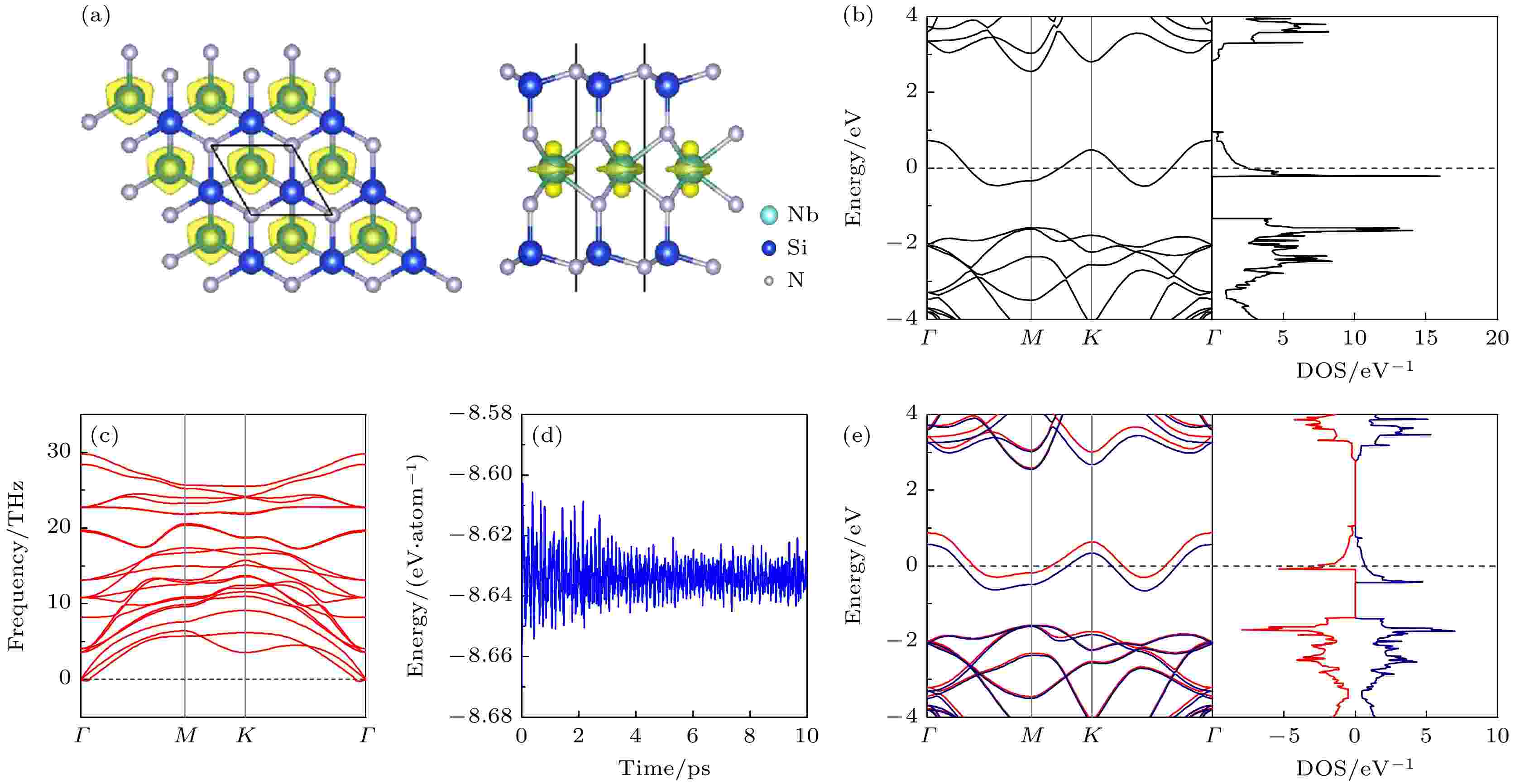
2022, 71 (20): 206303.
doi:10.7498/aps.71.20220939
Abstract +
The effective control of two-dimensional material magnetism is a frontier research field. In this work, the influences of in-plane biaxial tension strain on the electronic structure, magnetic properties, and Curie temperature of monolayer NbSi2N4are investigated by first-principles calculations based on density functional theory and Monte Carlo simulations in the frame of the Heisenberg model. We demonstrate that the monolayer NbSi2N4has favorable dynamic and thermal stability through the phonon spectral calculations and ab initio molecular dynamics simulations. It is found that the intrinsic monolayer NbSi2N4is a non-magnetic metal, which can be transformed into a ferromagnetic metal by 1.5% tensile strain. The electronic structure analysis of monolayer NbSi2N4shows that the ferromagnetism induced by tensile strain is caused by traveling electrons. There is a half-full band at the monolayer NbSi2N4Fermi level, which is mainly contributed by the dz2orbital of the Nb atom. When there is no additional strain, the band is spin-degenerate. Tensile strain can make this band more localized, which leads to Stoner instability, resulting in the ferromagnetic ordering of monolayer NbSi2N4traveling electrons. The stability of the ferromagnetic coupling is enhanced with the increase of the strain degree. The calculation results of the magnetic anisotropy energy show that the strain can make the direction of the easy magnetization axis of the monolayer NbSi2N4reverse from the vertical direction to the in-plane, and then back to the vertical direction. Furthermore, the strain can significantly increase the Curie temperature of monolayer NbSi2N4. The Curie temperature of monolayer NbSi2N4is 18 K at 2% strain and 87.5 K at 6% strain, which is 386% higher than that at 2% strain. Strain engineering can effectively control the magnetic ground state and Curie temperature of single-layer NbSi2N4. The research results are expected to promote the development ofMA2Z4materials in the field of mechanical sensing device design and low-temperature magnetic refrigeration.
CONDENSED MATTER: ELECTRONIC STRUCTURE, ELECTRICAL, MAGNETIC, AND OPTICAL PROPERTIES
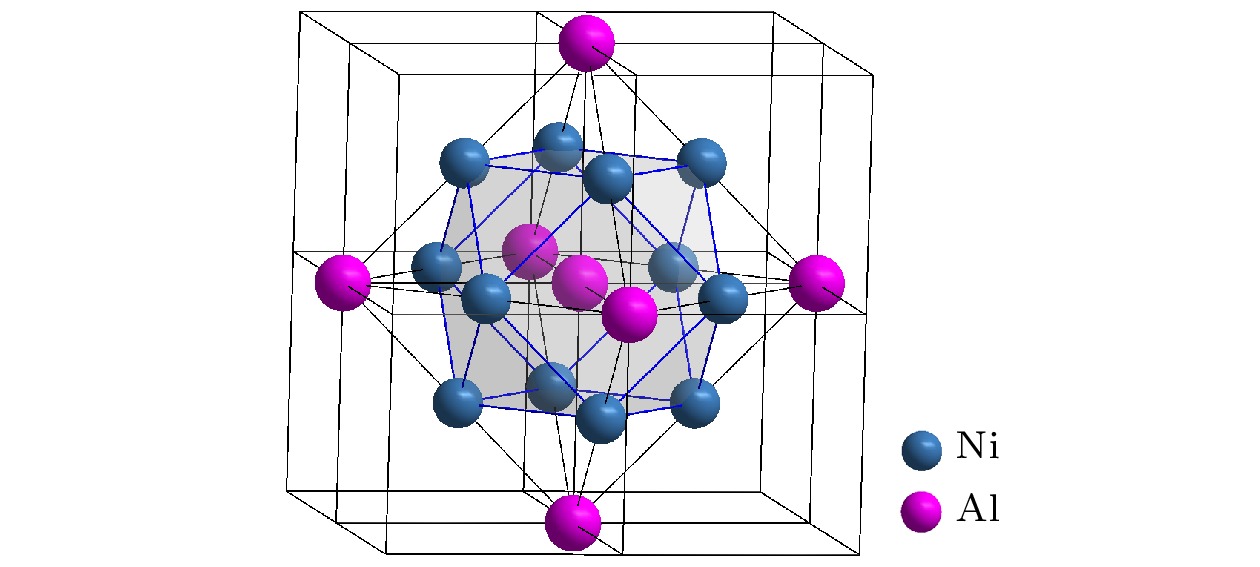
2022, 71 (20): 207101.
doi:10.7498/aps.71.20221036
Abstract +
The short range order and physical properties of Ni-Al-Cr alloys are studied by using the cluster-plus-glue-atom model. In the formula [Al-Ni12]AlxCr3–x,x= 0, 0.5, 1.0, 1.5, 2.0, 2.5, Al atom is selected as the center of cluster, then twelve Ni atoms which are arranged at the nearest neighboring sites constructe a cluster, and Al atoms and Cr atoms which are located at second neighboring sites are glue atoms. The results of formation energy show that the configurations of cluster-plus-glue-atoms model are more stable than the other configurations with all compositions. The results of difference charge density show that the charge density transfer of Ni-Al-Cr system is mainly accumulated between Ni and Al atoms or between Ni and Cr atoms. It means that Ni-Al and Ni-Cr are more easily bonded than Ni-Ni and Al-Cr. The electronic band structures indicate that Ni-Al-Cr alloy has conductor properties. The hybrid effects between Ni-3d and Al-3p or Ni-3d and Cr-3d are obvious, which verifies that there are strong interactions between Ni and Al atoms or between Ni and Cr atoms.
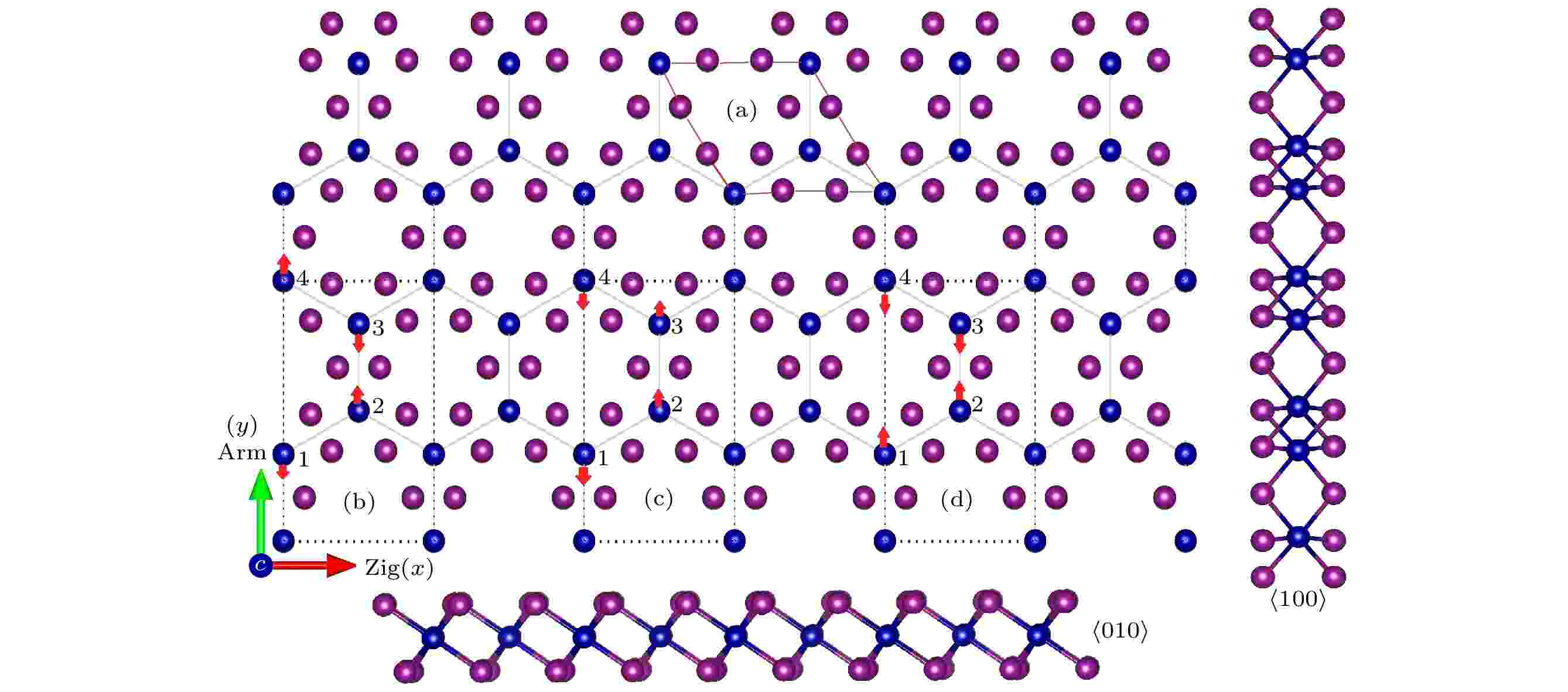
2022, 71 (20): 207102.
doi:10.7498/aps.71.20221019
Abstract +
Because the single-layer CrI3is a half semiconductor with indirect band gap and magnetic anisotropy, it has received much attention in the spintronic, magneto-electronic and magnetic storage applications. However, the knowledge of the dependence of carrier mobility and optical property on strain is still rather limited. The uniaxial and biaxial strain dependence of electronic, transport, optical and magnetic properties of single-layer CrI3are systematically investigated by using first-principles calculations, and the results are compared with experimental results. The electronic structures under different strains are first calculated by using the accurate HSE06 functional, then the carrier mobility is estimated by the deformation potential theory and the dielectric function is obtained to estimate the optical absorption especially in the visible light range. Finally, the magnetic anisotropy energy used to estimate the magneto-electronic properties is studied by the Perdew-Bueke-Ernzerhof functional including the spin-orbit coupling. It is found that the ferromagnetic CrI3is an indirect and half semiconductor with band gap 2.024 eV,
$ \Delta {\text{CBM}} $
= 1.592 eV,
$ \Delta {\text{VBM}} $
= 0.238 eV and can be driven into AF-Néel antiferromagnetic phase by applying –6% to –8% (compressive) biaxial stain, exhibiting excellent agreement with the results from the literature. It is found that of single-layer CrI3has very low carrier mobility with a value within 10 cm2·V–1·s–1due to the large effective mass and small in-plane stiffness can be remarkably increased by increasing biaxial compression strain attributed to the reduced effective mass. A high electron mobility 174 cm2·V–1·s–1is obtained in the zigzag direction by applying a –8% biaxial strain reaching the level of monolayer MoS2. The calculated imaginary component of dielectric function along thex(y) direction having two peaks (I, II) in the visible light range is obviously different from that along thezdirection, indicating that the single-layer CrI3has optical anisotropy, demonstrating the good agreement with results from the literature. It is found that the imaginary part of dielectric function shows that an obvious redshift and peak (I, II) values strongly increase with the increase of compressive strain (biaxial), showing good agreement with the calculated electronic structures and indicating that monolayer CrI3possesses high optical adsorption of visible light under a compressive biaxial strain. Furthermore, it is found that the magnetic anisotropy energy of monolayer CrI3mainly stemming from the orbital magnetic moment of Cr ions remarkably increases from 0.7365 to 1.08 meV/Cr with g compressive strain increasing. These results indicate that the optoelectronic property of single-layer CrI3can be greatly improved by applying biaxial compressive strain and the single-layer CrI3is a promising material for applications in microelectronic, optoelectronic and magnetic storage.
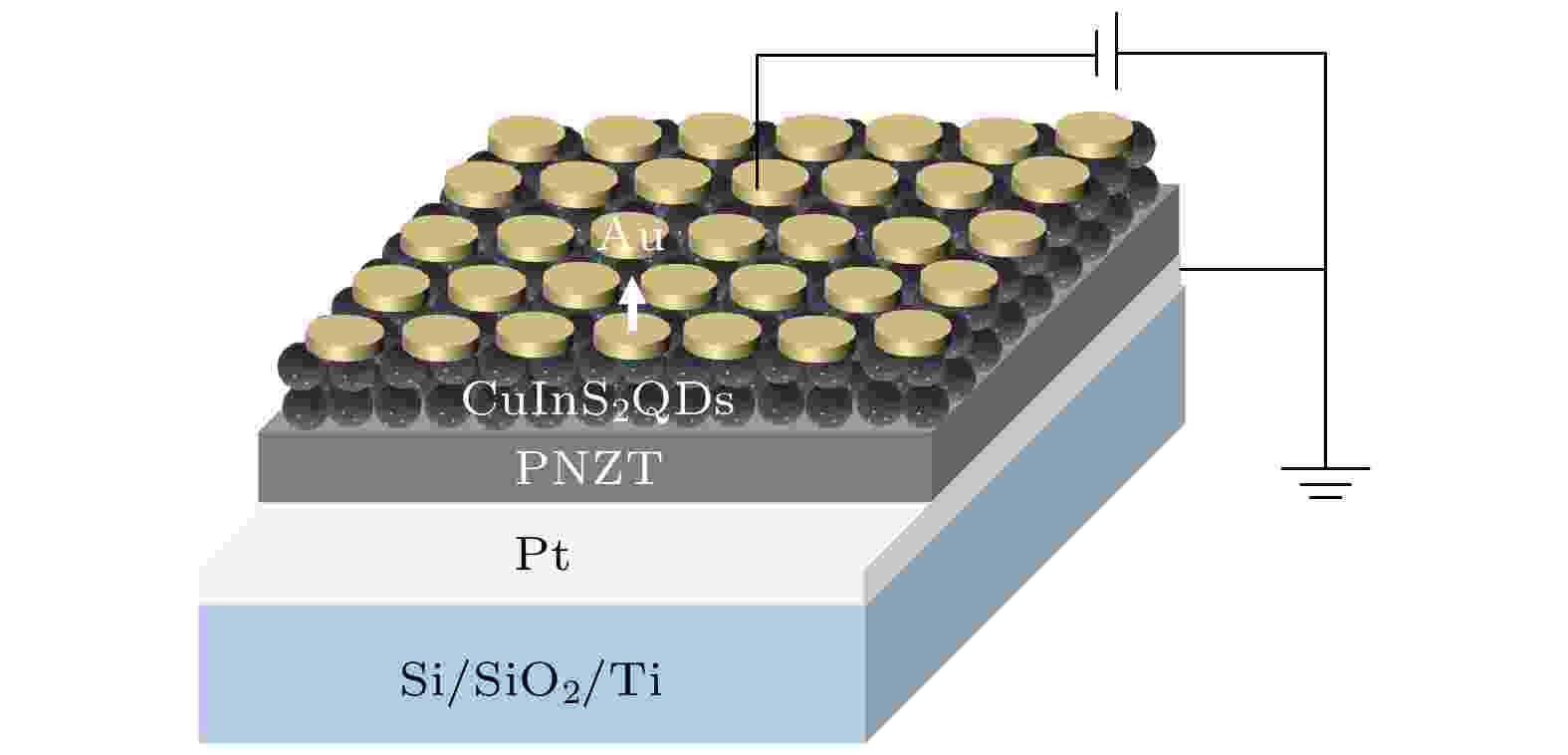
2022, 71 (20): 207301.
doi:10.7498/aps.71.20220911
Abstract +
As a new type of non-volatile memory, quantum dot resistive random access memory (RRAM) has attracted much attention for its easy preparation, fast responding time, high storage density, and smaller device size. CuInS2quantum dot (CuInS2QD) is a kind of excellent resistive functional material with abundant electron capture sites, high optical absorption coefficient, and high carrier mobility. In this work, CuInS2QDs/Nb:Pb (Zr0.52Ti0.48)O3(PNZT) films are prepared by spin-coating CuInS2QDs on PNZT films. The results show that the resistive properties of CuInS2QDs RRAMs can be effectively improved by introducing PNZT films and can be controlled by changing the polarization direction. The CuInS2QDs/PNZT film in the negative polarization state promotes the interfacial electrons to enter into the PNZT film, which will reduce the height of the interfacial barrier and the thickness of the interfacial depletion region. And it will reduce the resistance of the composite film at the low resistance state (LRS). Compared with the switching voltage and resistive switching ratio of the pure CuInS2QDs film (103), the switching voltage of the device decreases to –4.1/3.4 V and the resistive switching ratio increases to 106. Furthermore, it maintains good stability in the 103cycle durability test. In contrast, the CuInS2QDs/PNZT film interface has a larger barrier height and depletion-layer thickness when the PNZT is in the positive polarization state, which increases the resistance of the composite film in the LRS state. As a result, the switching voltage of the device increases to –6.4/5.7 V with a resistive switching ratio of 104. The resistive properties of the CuInS2QDs/PNZT film can be tuned by changing the polarization direction, as the polarization direction of the PNZT changes the interfacial energy band structure and affects the conduction mechanism. This work reveals the feasibility of using ferroelectric thin films to improve the resistive properties of quantum dots RRAMs and thus providing an approach to further developing RRAMs.
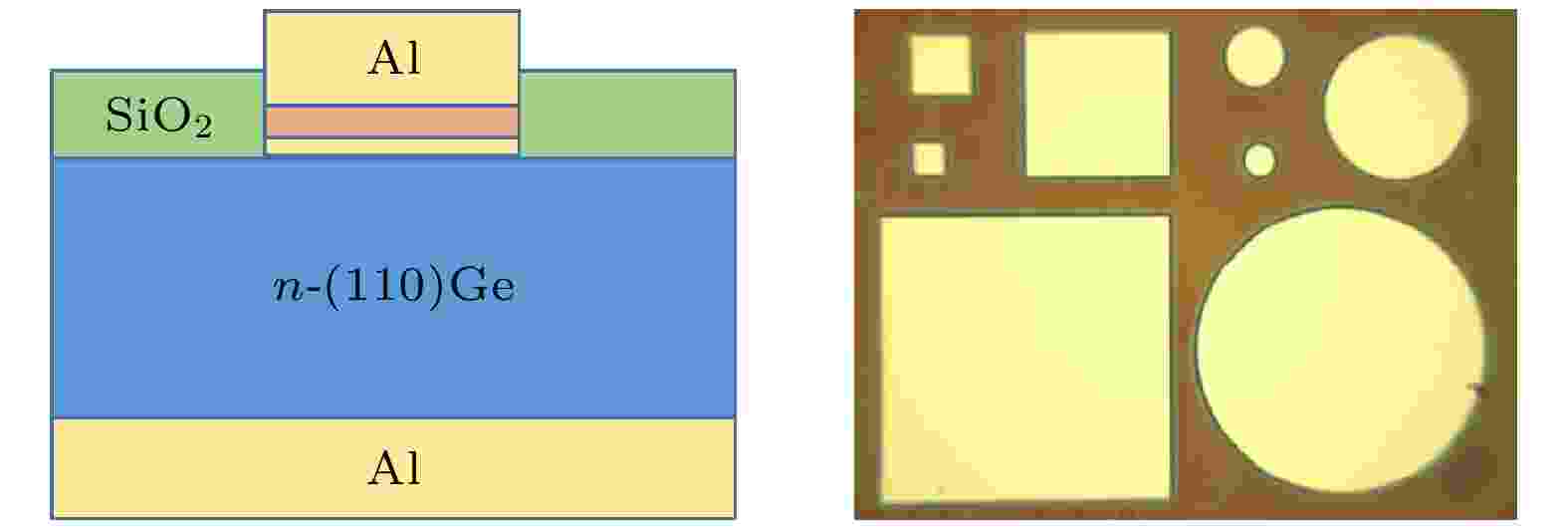
2022, 71 (20): 207302.
doi:10.7498/aps.71.20220320
Abstract +
NiGe/n-Ge Schottky barrier height is modulated by Ni/n-Ge reaction with 1 nm Al as an intermediate layer. The series resistance, barrier height and ideal factor of Schottky diodes are extracted by the forwardI-Vmethod, Cheung method and Norde method, respectively. Comparing with Ni/n-Ge SBD, the introduction of 1 nm Al insertion layer between Ni and Ge substrates can effectively reduce the barrier height and maintain stability between 350 ℃ and 450 ℃.
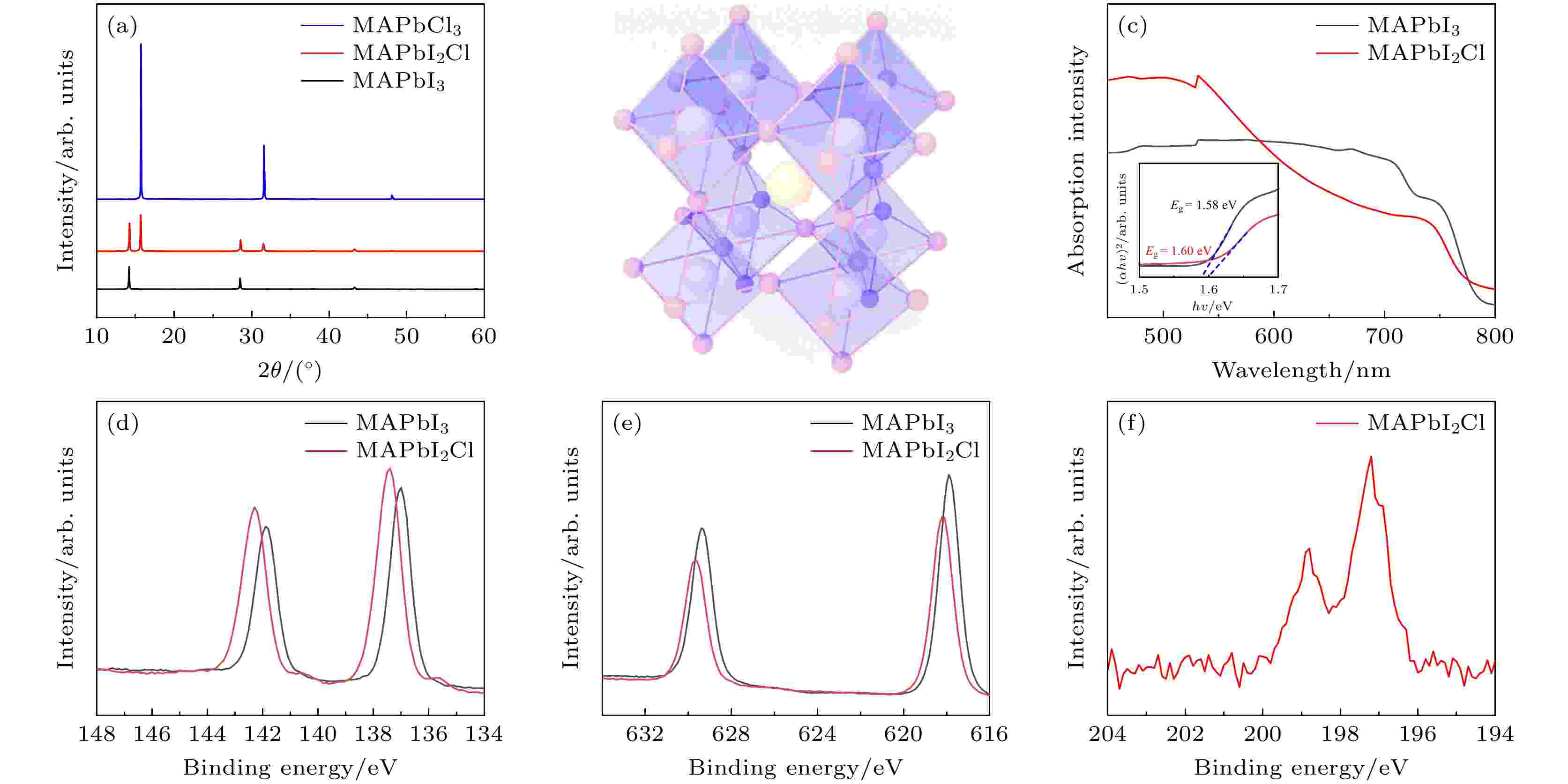
EDITOR'S SUGGESTION
2022, 71 (20): 207303.
doi:10.7498/aps.71.20220966
Abstract +
Metal halide perovskite (MHP) has been widely used in optoelectronic devices such as solar cells in recent years due to their high absorption coefficients, long-range charge carrier diffusion lengths, and adjustable band gap, which is expected to achieve commercial application. Methylammonium lead iodide (MAPbI3) has been fully investigated as a standard perovskite component, however, due to the low formation energy of polycrystalline films fabricated by wet chemical method, crystal defects (including interface and grain boundary defects) are generally inevitable, which is a principal factor leading to phase transition. Therefore, reducing the defect density of perovskite is a prominent approach to improve the stability of perovskite. Although defect passivation is one of the most commonly used methods to fabricate efficient perovskite solar cells (PSCs), the relatively weak secondary bond between molecular passivation group and perovskite crystal may bring difficulties to the application of practical devices, particularly when operating under harsh environments, such as high temperature, humidity, and ultraviolet light. Therefore, improving the intrinsic structure stability of the perovskite via changing its composition can be an effective way. Although perovskites containing chlorine precursors have been empolyed in solar cells device, how chloride ions affect the structural and electronic properties of these films was not understood yet. In this work, two-phase perovskite (MAPbI2Cl) was fabricated by one-step spin coating with methylamine chloride (MACl) and lead iodide (PbI2) as precursors. As a result, chloride (Cl) doping can superiorly induce perovskite crystallization and thus stabilize the MAPbI3lattice. The Cl doped perovskite layer shows lower defect density, and compared with the original MAPbI3film, the carrier lifetime of MAPbI2Cl is increased by 7 times. Simultaneously, both of PCE and operational stability have been largely improved with PCE increased from 11.41% to 13.68%. There is no obvious degradation in the maximum power point output for nearly 8000 seconds in ambient conditions.
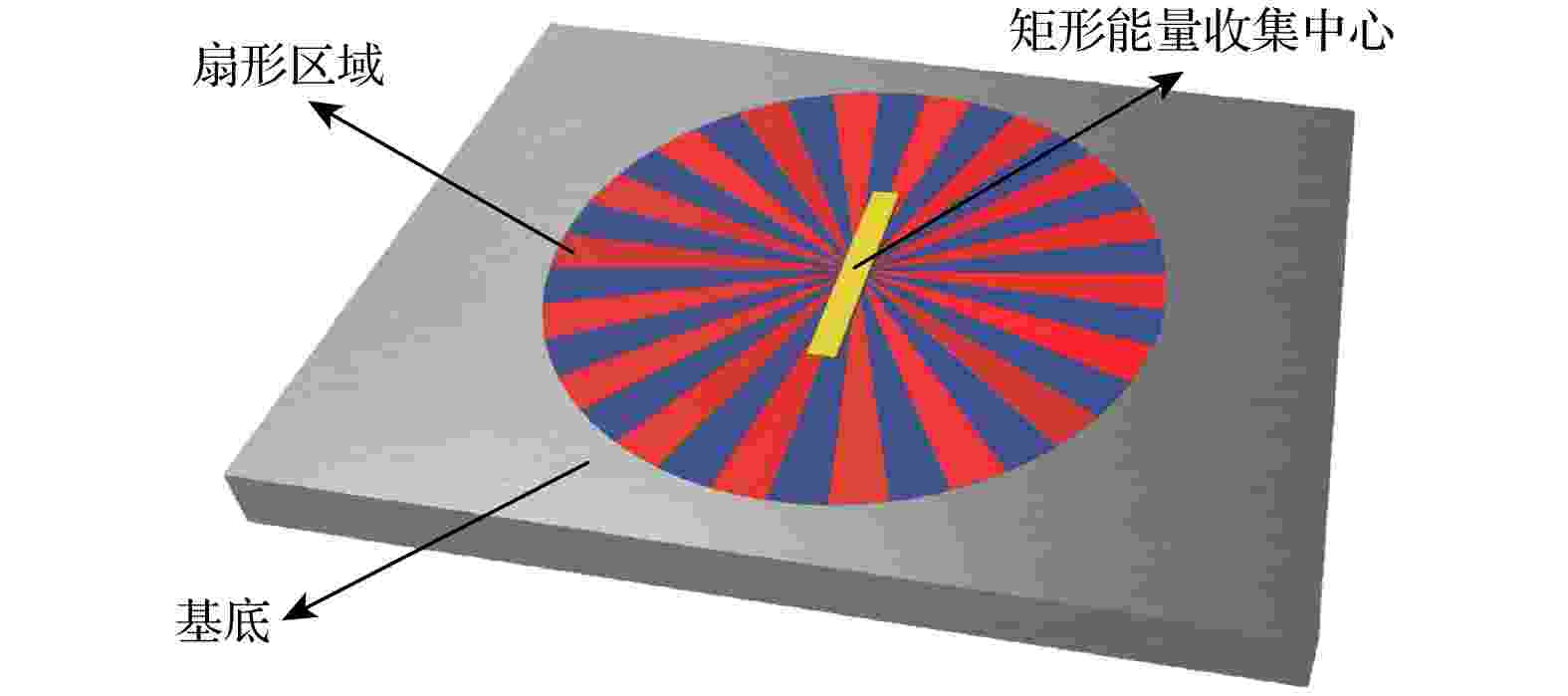
2022, 71 (20): 207304.
doi:10.7498/aps.71.20221061
Abstract +
Considering the limitations of thermoelectric generators, the integration of thermoelectric generator with two-dimensional fan-shaped thermal metamaterial energy harvesting device is proposed to improve the thermal-to-electrical energy conversion efficiency of thermoelectric generator (TEG) by regulating the thermal field. Based on the COMSOL Multiphysics software simulation, the influences of different materials on the performances of energy harvesting devices in thermal field regulation are investigated. The performances of the selected materials are simulated , indicating that the energy harvesting device can effectively regulate heat flow, the temperature gradient in the center of it is increased by eight times compared with the natural material under the same simulation conditions. The generated electrical energy of thermoelectric generators of different sizes is studied, then three-dimensional modeling and processing of the energy harvesting device are completed by carefully considering the processing accuracy and testing difficulty. The experimental test system is set up to observe the temperature distribution of the energy harvesting device equipped with an infrared thermal imager, The test results demonstrate that the energy harvesting device can effectively regulate the thermal field. In comparison with the natural material, the working efficiency of the thermoelectric generators can be increased by 3.2 times under the same experimental condition, which has specific practical significance for promoting the rapid development of thermoelectric power generation technology.
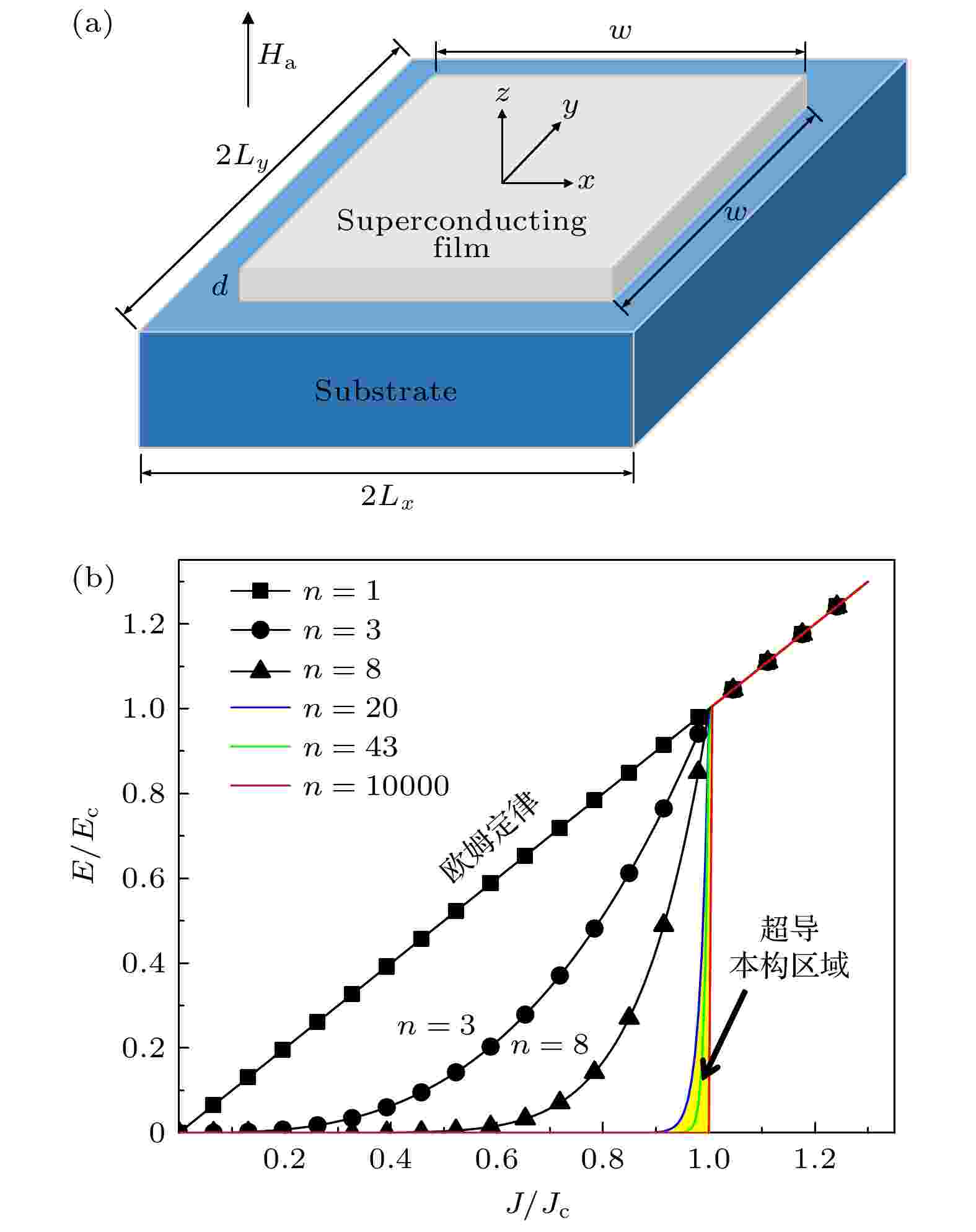
2022, 71 (20): 207401.
doi:10.7498/aps.71.20220285
Abstract +
The
$E\text{-}J$
relationship in conventional conductor generally satisfies the linear Ohm's law. However, the
$E\text{-}J$
model in superconductors presents strong nonlinear characteristics, which is significantly different from that of the conventional conductor. According to the nonlinear
$E\text{-}J$
power law of superconducting materials, we quantitatively investigate the relationship between the magnetic-thermal stability and the nonlinear constitutive characteristic of superconducting films at different temperatures, magnetic field ramp rates, and critical current densities by using the fast Fourier transform method (FFT). We find that the strong nonlinear electromagnetic constitutive model plays a crucial role responsible for the onset and morphology (tree-like and finger-like) of the magneto-thermal instability of superconducting thin films. In addtion, the reason why similar magneto-thermal instabilities cannot be observed in conventional conductors is also explained. It can be found that the magnetic field on the border of the superconducting film increases rapidly for a larger creep exponent due to the enhancement of diamagnetism, which results in a large magnetic pressure and easily triggering off flux avalanches. Therefore, the threshold field of flux avalanches in the superconducting film decreases with flux creep exponent increasing. Finally, we present the curves that can clearly divide the
$n_0\text{-}j_{c0}$
plane and
$n_0\text{-}\dot {H}_a$
plane into magneto-thermal stability region and magneto-thermal instability region for superconducting thin film with different levels of nonlinearity.
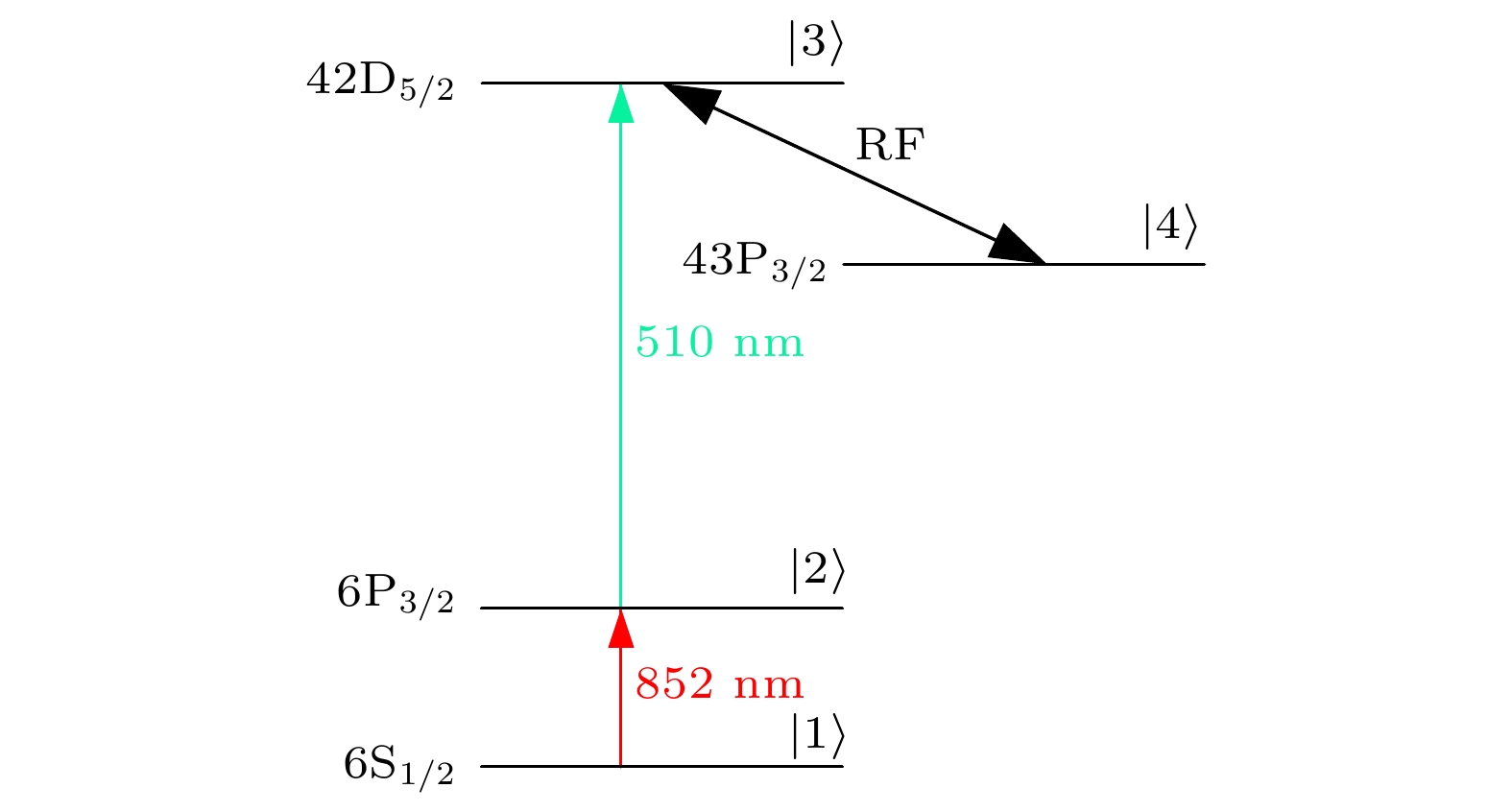
EDITOR'S SUGGESTION
2022, 71 (20): 207402.
doi:10.7498/aps.71.20220972
Abstract +
Rydberg atom is an atom with a high principal quantum number. Its quantum coherence effect enables the measuring of radio frequency electric fields in space. In this work, the radio frequency pulse response characteristics of the radio frequency receiving system based on the Rydberg atom under different pulse widths and intensities are studied. In the experiment, lasers with wavelengths of 852 nm and 510 nm are used to excite cesium atoms. Moreover, a radio frequency source emits pulse signals with different parameters to irradiate Rydberg atoms. The probe signal transmitted from the atomic vapor cell is directed at the photodetector. Moreover, the oscilloscope records the electrical signal obtained by photoelectric conversion. In addition, the simulation ranging is performed by setting different pulse delay times through the fiber delay instrument. It preliminarily proves that the radio frequency receiving system based on Rydberg atoms has a function of pulse ranging.
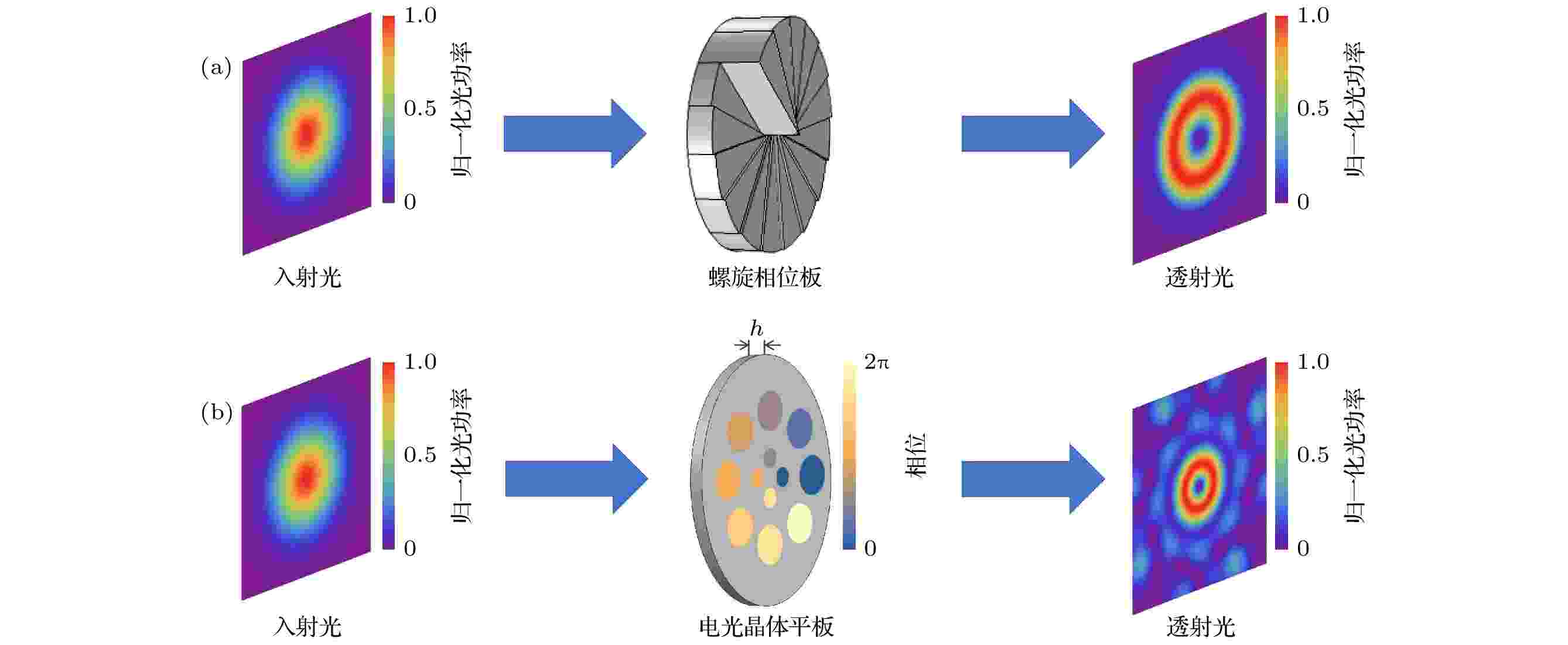
Dynamic generation of vortex beam based on partial phase modulation of electro-optical crystal plate
2022, 71 (20): 207801.
doi:10.7498/aps.71.20220835
Abstract +
With the increasing demand for potential applications of vortex beams in various fields of modern optics, the generation of optical vortex beams has attracted great interest. Based on a flat plate made of an electro-optical crystal, a method to generate optical vortex beams assisted by the Pockels effect is proposed. This method allows an orbital-angular-momentum-tunable range of
$ \pm 2\hbar$
with a finite phase-modulated region. We simulate the propagation of optical beams transmitted from the flat plate and investigate the orbital-angular-momentum-mode spectra of the transmitted optical beams. The mode spectra accord well with the simulation results. The proposed method will be applied to fields where tunable optical vortex beams are required, such as optical communication and optical manipulation.
INTERDISCIPLINARY PHYSICS AND RELATED AREAS OF SCIENCE AND TECHNOLOGY

EDITOR'S SUGGESTION
2022, 71 (20): 208201.
doi:10.7498/aps.71.20221050
Abstract +
Ternary lithium metal halides have attracted much attention as potential solid electrolytes. In this work, we study the structural, electronic and ionic diffusion properties of a series of LixYCl3+x(x= 2.14, 3.00, 4.20) and LixYBr3+x(x= 1.8, 3.0, 5.0) by using first-principles calculation based on density functional theory. The calculation results show that the Li-ion concentration has a significant effect on the properties of the materials, and with the increase ofxvalue, Li-ion number becomes higher, structure turns more stable, band gap gets larger, and migration barrier lowers, thus the performance of the material can be tuned. In addition, the calculation results further show that Li3YCl6and Li3YBr6with the best balance between Li-ion carrier concentration and vacancy concentration exhibit the highest structural stability, the largest band gaps, and the lowest migration barriers in all similar structures. Our study provides a new strategy and idea for designing better-performance halide solid electrolytes.

2022, 71 (20): 208401.
doi:10.7498/aps.71.20220855
Abstract +
Rectifier component is a core part of a microwave wireless energy transmission system, and the development of new rectifier components is an important research direction in this field. Schottky diodes and field-effect transistors are currently the mainstream rectifier devices, but they have a limited rectification range and cannot achieve a wide-range rectification of both weak energy and medium energy density at the same time. In view of this, in this work proposed and designed is a Ge based p-type single-ended Schottky barrier field effect transistor (Schottky contact at the source and standard p+doping at the drain) for 2.45 GHz microwave wireless energy transmission. Based on this, the Schottky structure of the device is fully utilised and a new diode connection is used in order to realize a dual channel wide range rectification of the trench and source lined Schottky structure opened at different bias voltages. Simulations are carried out by using the Silvaco TCAD software. For a half-wave rectifier circuit with a load of 0.3 pF and 70 kΩ, a wide range from –20 to 24 dBm rectification is achieved, which is 8 dBm wider than the range of Ge field-effect transistors under the same conditions, and the overall rectification efficiency is higher in the range, with a peak rectification efficiency of 57.27% at 16 dBm. The rectification efficiency at –10 dBm weak energy density reaches 6.17%, which is more than 7 times that of Ge FETs under the same conditions.

2022, 71 (20): 208501.
doi:10.7498/aps.71.20220859
Abstract +
Gallium oxide (Ga2O3) has the natural advantages in deep ultraviolet absorbance for performing deep ultraviolet photodetection. Owing to the vital application of photodetector array in optical imaging, in this work, we introduce a 4×4 Ga2O3-based photodetector array with five-finger interdigital electrodes, in which the high-quality and uniform Ga2O3thin film is grown by using metal-organic chemical vapor deposition technique, and the device is fabricated by using the following methods: ultraviolet photolithography, lift-off, and ion beam sputtering . The photodetector cell possesses a responsivity of 2.65×103A/W, a detectivity of 2.76×1016Jones, an external quantum efficiency of (1.29×106)%, and a photoconductive gain as high as 12900. The 16-cells in this array show good uniformity. In this work the great application potential of gallium oxide deep ultraviolet detector array is illustrated from the perspective of optoelectronic performance and application prospect.
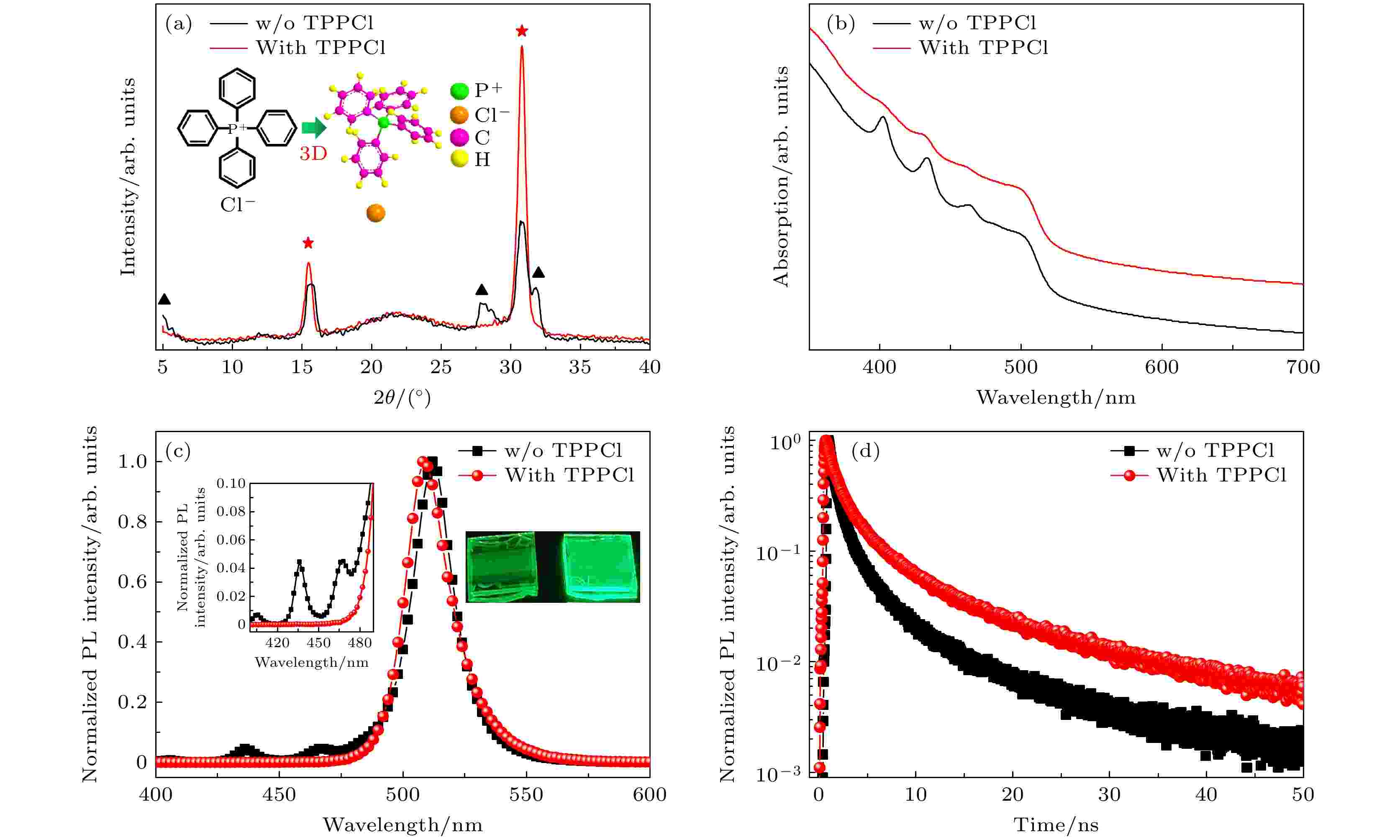
2022, 71 (20): 208502.
doi:10.7498/aps.71.20220858
Abstract +
Metal halide perovskite has attracted much attention due to its adjustable color, high color purity, and excellent photoelectric properties. The quality of the perovskite film is one of the key factors that affect the performance of device. Here, PEA2Csn–1PbnBr3n+1thin films are prepared by directly doping the ionic compound additive tetraphenylphosphine chloride (TPPCl) into the perovskite precursor of the light-emitting layer based on additive assisted technology. High-quality perovskite films with uniform, less pinholes and smaller grains are obtained. Not only is the photoluminescence (PL) performance of PeLEDs improved but the electroluminescence (EL) performance of PeLEDs with a double electron transport layer also turns better. The maximum brightness is 25285 cd/m2. The maximum current efficiency is 65.9 cd/A. And the maximum EQE is 17.3%. The method of adding ionic compounds to the perovskite precursor can not only improve the carrier transport behavior, but also make the formed small n crystal phases and large n crystal phase more balance, leading to the energy funnel effect to be enhanced. Further investigation by FTIR proves that the TPPCl can passivate the perovskite film, and thus greatly improving the EQE value of the PeLED. This researchpresents a simple and efficient method of developing high-performance quasi-two-dimensional green PeLEDs.
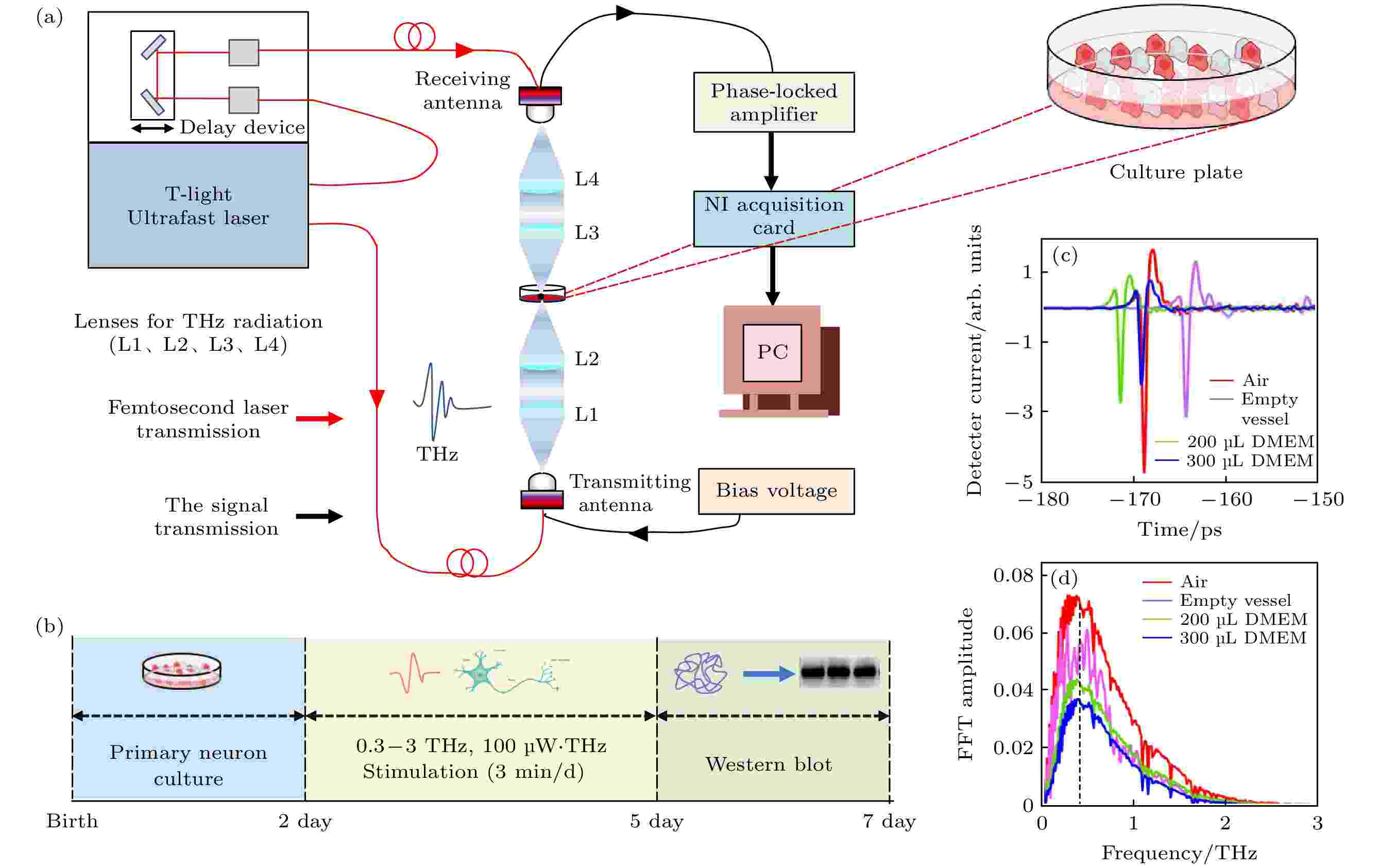
2022, 71 (20): 208701.
doi:10.7498/aps.71.20220636
Abstract +
Terahertz waves are located in the energy level range of hydrogen bonding and van der Waals forces, and can directly couple with proteins to excite the nonlinear resonance effect of proteins. Therefore, terahertz wave can affect the conformation of proteins, the structure and function of neurons. Primary cerebral cortex neurons of SD rats are cultured in vitro. Neurons are radiated 3 days by THz wave with 0.3–3.0 THz in frequency and 100 μW in power; the growth and development indicators of neurons (Cell body area, total length of process) are recorded. At the end of a radiation programme, Western blotting is used to detect the protein expressions of GluA1, GluN1, postsynaptic density protein-95 (PSD-95) and synaptophysin 38 (SYP-38). After the first day of terahertz wave radiation, the cell area is increased by 144.9% (P< 0.05); on the second day and third day of terahertz wave radiation, the growth value of the total length of neuronal neurites are increased by 65.1% (P< 0.05) and 109.4% (P< 0.05), respectively. After the three-day terahertz wave irradiation, the protein expressions of GluA1 and SY-38 are increased by 38.1% (P< 0.05) and 19.2% (P< 0.05), respectively. In addition,some results show below. 1) The use of low-intensity broadband terahertz wave in this study will not cause the cortical neurons to die, and will not affect their regular growth. 2) Low-intensity broadband terahertz radiation can promote the growth of cortical neuron cell bodies and processes, but the effects on cortical neuron cell bodies and processes are different. This may be related to the developmental cycle of cultured cortical neurons in vitro, and there is a cumulative effect on the promotion of neuronal processes by low-intensity broadband terahertz. 3) The promotion of neuronal growth and development by low-intensity broadband terahertz wave radiation may be related to the proportion of AMPA receptor subtypes and the expression of presynaptic specific protein SY-38. These results herald a specific-frequency and specific-energy terahertz radiation can be developed into a novel neuromodulation technology for the treatment or intervention of diseases such as neurodevelopmental disorders.
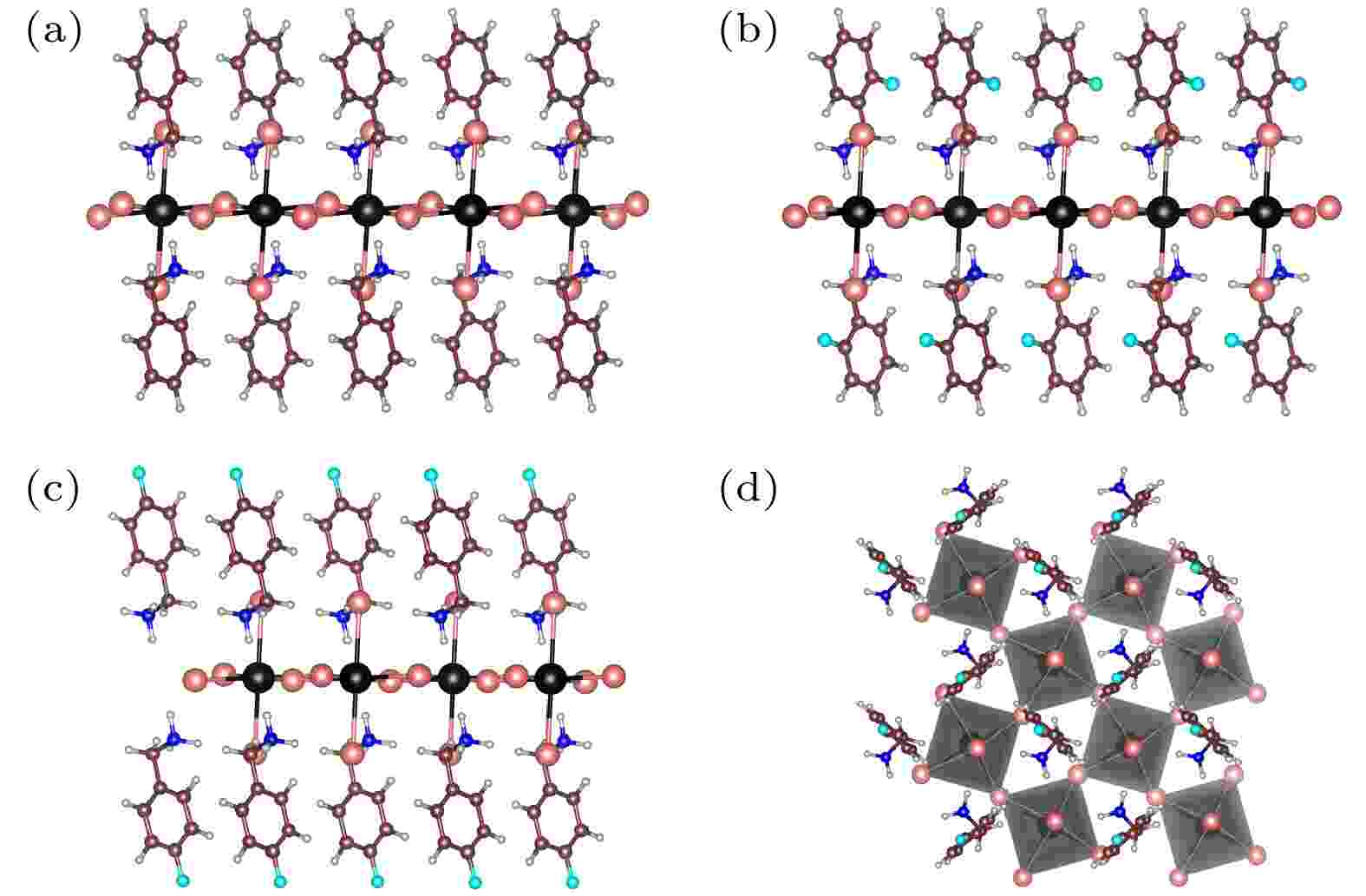
2022, 71 (20): 208801.
doi:10.7498/aps.71.20220802
Abstract +
Two-dimensional lead halide perovskite solar cell has shown great potential applications because of its relatively high stability in comparison with normal three-dimensional perovskite. More and more two-dimensional lead halide perovskites are used as absorbers in solar cells, but theoretical study on the structure-performance relationship of two-dimensional lead halide perovskites is still lacking. Therefore, starting form 3 kinds of fluorobenzylamine perovskites, first-principle calculations are carried out. By comparing their crystal structures, non-covalent interactions, formation energy, band structures, exciton binding energy, carrier mobilities of theses perovskites, and short-circuit current densities of their corresponding solar cells, the influences caused by organic spacers on the structural and electronic properties are studied. This research shows that the more negative the formation energy, the higher the stability of the optoelectronic device is, and the smaller the exciton binding energy, the larger the short-circuit current of the optoelectronic device is. A relationship for quantitative prediction of short-circuit current is proposed, and substitution with electron-withdrawing groups at the end of the spacer is expected to improve both the stability and short-circuit current density of optoelectronic device. The research results of this work can contribute to the design of new perovskite solar cells with high conversion efficiency.
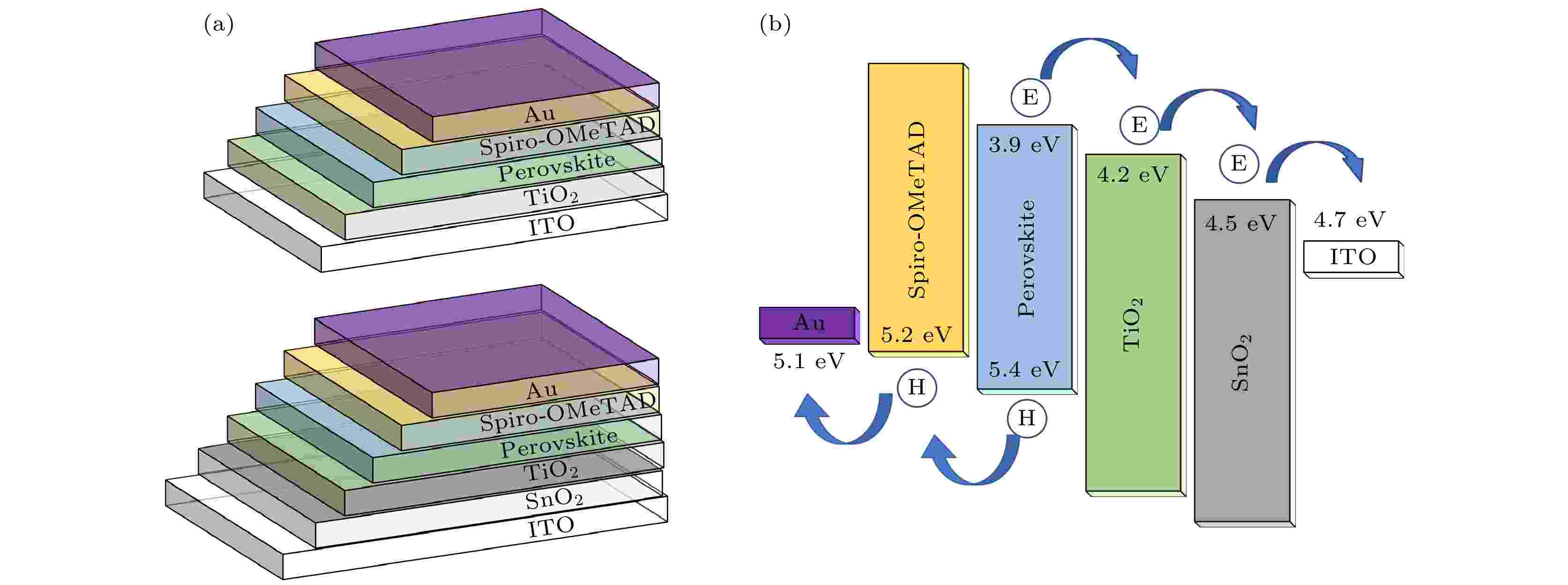
2022, 71 (20): 208802.
doi:10.7498/aps.71.20220725
Abstract +
With their excellent photoelectric properties, perovskite solar cells have become the most promising photovoltaic devices in recent years. However, owing to defects and energy level misalignment, the non-radiative recombination loss of the perovskite solar cell will increase, which hinders the its efficiency and operational stability from being improved further. Therefore, it is very important to reduce the loss caused by energy level misalignment for realizing high-efficiency perovskite solar cells. In order to solve the above-mentioned problems, perovskite solar cell with dual electron transport layer (ETL) is studied in this work. The dual-layer structure forms a stepped conduction band structure to reduce the conduction band offset between the active layer and the transport layer, which reduces the interface recombination between the two structures and improves device performance. In addition, the influences of the defect density on the cell performance for the two ETL structures are also discussed. With the continuous increase of the defect density, the performance of the single-layer structure decreases more obviously. While the dual ETL structure can alleviate the performance dependence on the defect density in comparison with the single ETL structure. Therefore, the use of dual ETL can improve the performance of perovskite solar cells and defect tolerance, which provides guidance for designing high-performance solar cells.
GEOPHYSICS, ASTRONOMY, AND ASTROPHYSICS

EDITOR'S SUGGESTION
2022, 71 (20): 209501.
doi:10.7498/aps.71.20220841
Abstract +
The space-based gravitational wave detection can acquire the gravitational wave source information with larger characteristic mass and scale, forming a complementary detection scheme with ground-based gravitational wave detection, primordial gravitational wave detection, and pulsar gravitational wave detection. The space-based gravitational wave detection is based on a long-distance laser interference device, which mainly detects gravitational wave signals in a frequency range of 0.1 mHz–1 Hz. The noise evaluation and noise suppression of the laser light source system directly affect the detection sensitivity. In this work, based on low-noise photoelectric detection, a very low-frequency laser intensity noise test and evaluation system is constructed with high-precision digital multimeter, software control and algorithm programming of the host computer. The laser intensity noise can be converted into the fluctuation of the current signal by utilizing the photodiode, and the current signal is converted into the voltage signal and amplified by the transimpedance circuit. Thus the high-frequency interference components are filtered out by a passive low-pass filtering, and the extremely low-frequency noise components are retained. According to the definition of shot noise, it can be known that the photocurrent injected into the detector is inversely proportional to the shot noise, so at least 5 mW laser is chosen for photoelectric detection. After controlling the high-precision digital multimeter through LabVIEW software programming, the acquisition is detected. The output voltage signal by the laser is subjected to the fast Fourier transform and logarithmic frequency axis power spectral density estimation algorithm for noise evaluation in the frequency domain, forming a complete laser intensity noise evaluation and measurement system. The 0.1 mHz–1 Hz frequency band laser intensity noise evaluation is finally obtained. The experimental results show that the noise of the high-precision multimeter in a frequency band of 0.1 mHz–1 Hz is lower than 5×10–5V/Hz1/2; the noise of the detector electronics ina frequency band of 0.1 mHz–1 Hz is lower than 4×10–5V/Hz1/2. The electronic noise of the high-precision multimeters and the detectors meet the requirements for space gravitational wave detection. The experimental results show that the 0.1 mHz–1 Hz frequency band laser intensity noise evaluation system we built meets the needs of space-based gravitational wave detection program, and provides an important foundation for building a laser source that meets the needs of space-based gravitational wave detection.








































